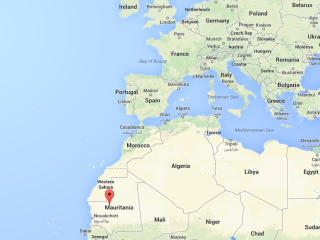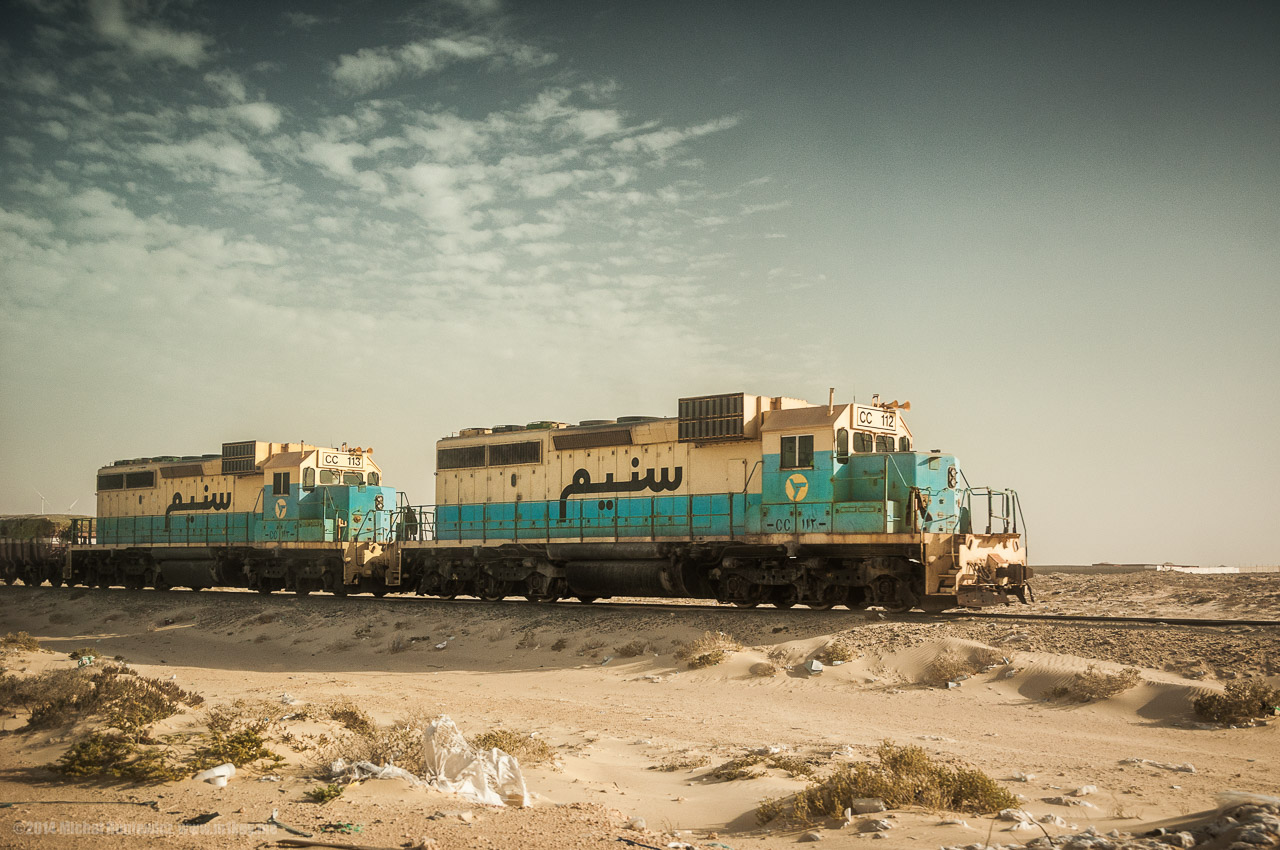Mauritania Part 2 Photography - M1key - Michal Huniewicz

This is part 2 of my photos from the West African country of Mauritania.
Just as I did in part 1, here, too, I will provide a bit of travel advice, as Mauritania is poorly documented travel-wise. Also, there will be some photography advice, as certain mistakes I made damaged my equipment, sadly. Paying for my own stupidity! Oh well.
Please like my Facebook Page for updates and photo previews!
Sources: 1,
2,
3,
4,
5,
6,
7,
8,
9,
10,
11,
12,
13,
14.
Uploaded on: 2014-08-09.
Cameleers
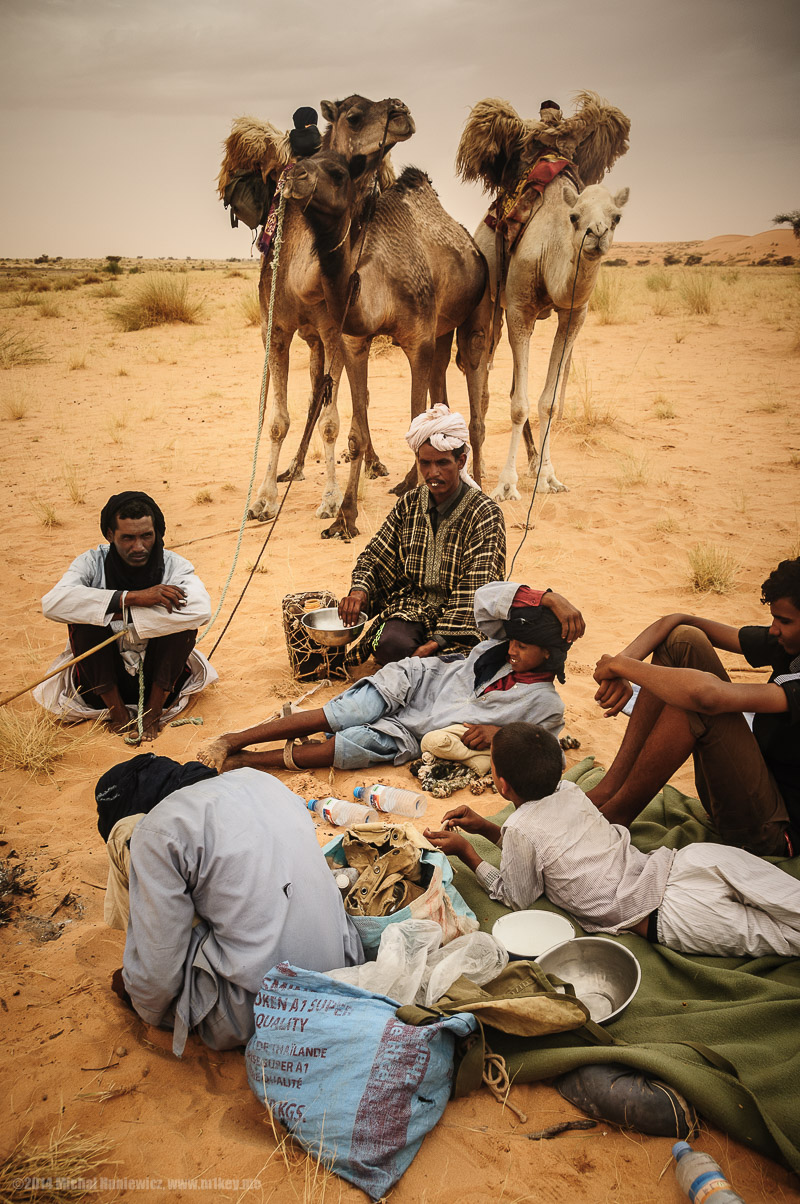
This is where we left off, the desert people. I suspected they might be Tuareg, but someone pointed out that I could be wrong.
On the other hand, bartjeej kindly told me that while those people could be "culturally mostly Arab and genetically mostly Berber", and referred to as white moors or bidan, they might as well be Tuareg, after all, as some Tuareg people moved to Mauritania following the conflicts in Northern Mali. [5]
This is also where I began to bleed from the nose, and Ahmed told me to put something he had found in the desert up my nose - which later turned out to be camel poop.
On the other hand, bartjeej kindly told me that while those people could be "culturally mostly Arab and genetically mostly Berber", and referred to as white moors or bidan, they might as well be Tuareg, after all, as some Tuareg people moved to Mauritania following the conflicts in Northern Mali. [5]
This is also where I began to bleed from the nose, and Ahmed told me to put something he had found in the desert up my nose - which later turned out to be camel poop.
ISO 200, 24mm, f/8.0, 1/200s.
Welcome to the Library
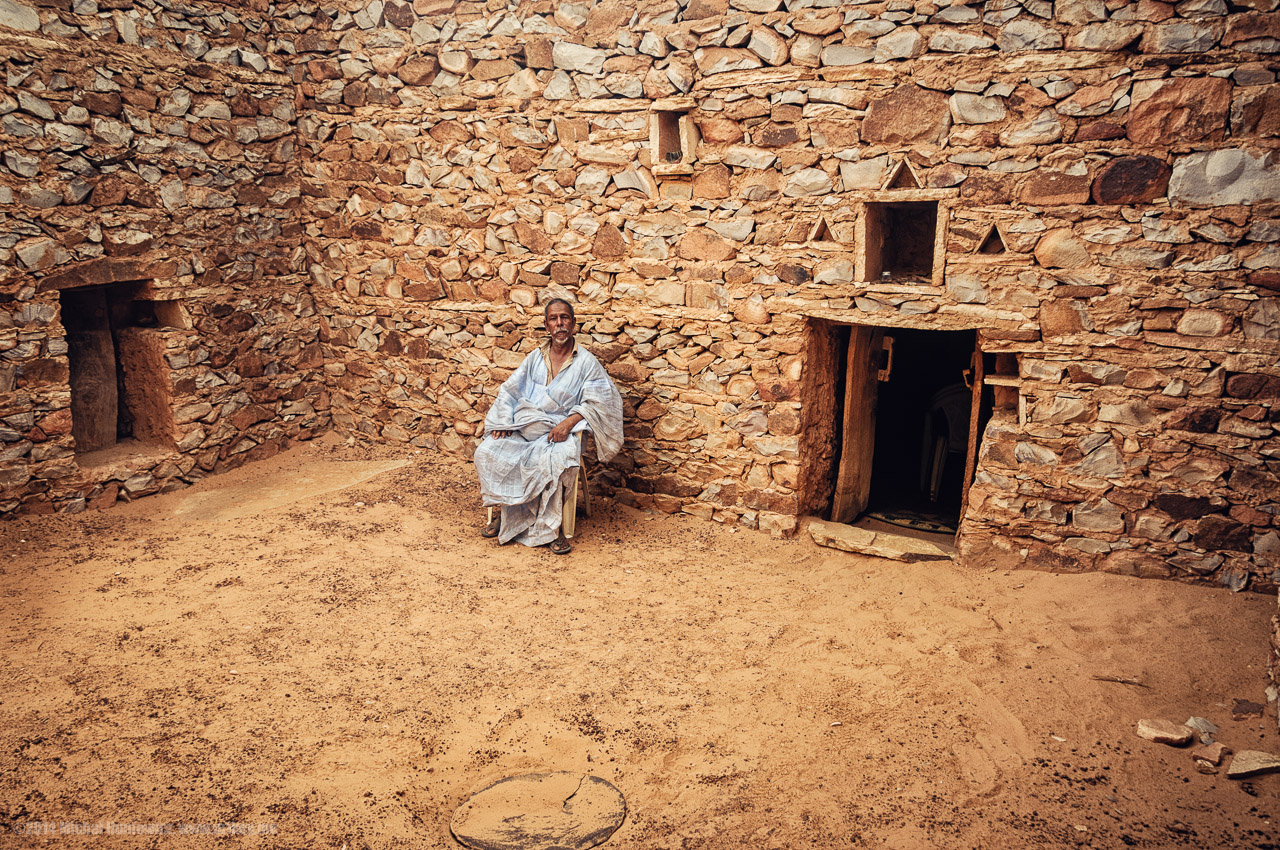
Later that day, we made it to Chinguetti, a medieval trading centre founded in 777 AD [1], sometimes referred to as the seventh-most holy city of Islam (but this isn't something all Muslims recognise).
Chinguetti was famous for its libraries, some of which contained works on science, astronomy, maths, etc. This oasis town has always been struggling against the Sahara, and it has already had to relocate (slightly) twice,
being swallowed up by the relentless sands.
There are still some libraries you can visit, but their number has been decreasing for centuries. This is the Al Ahmed Mahmoud Foundation Library. Its guardian is awaiting those who seek knowledge.
There are still some libraries you can visit, but their number has been decreasing for centuries. This is the Al Ahmed Mahmoud Foundation Library. Its guardian is awaiting those who seek knowledge.
ISO 200, 18mm, f/5.0, 1/60s.
The Key
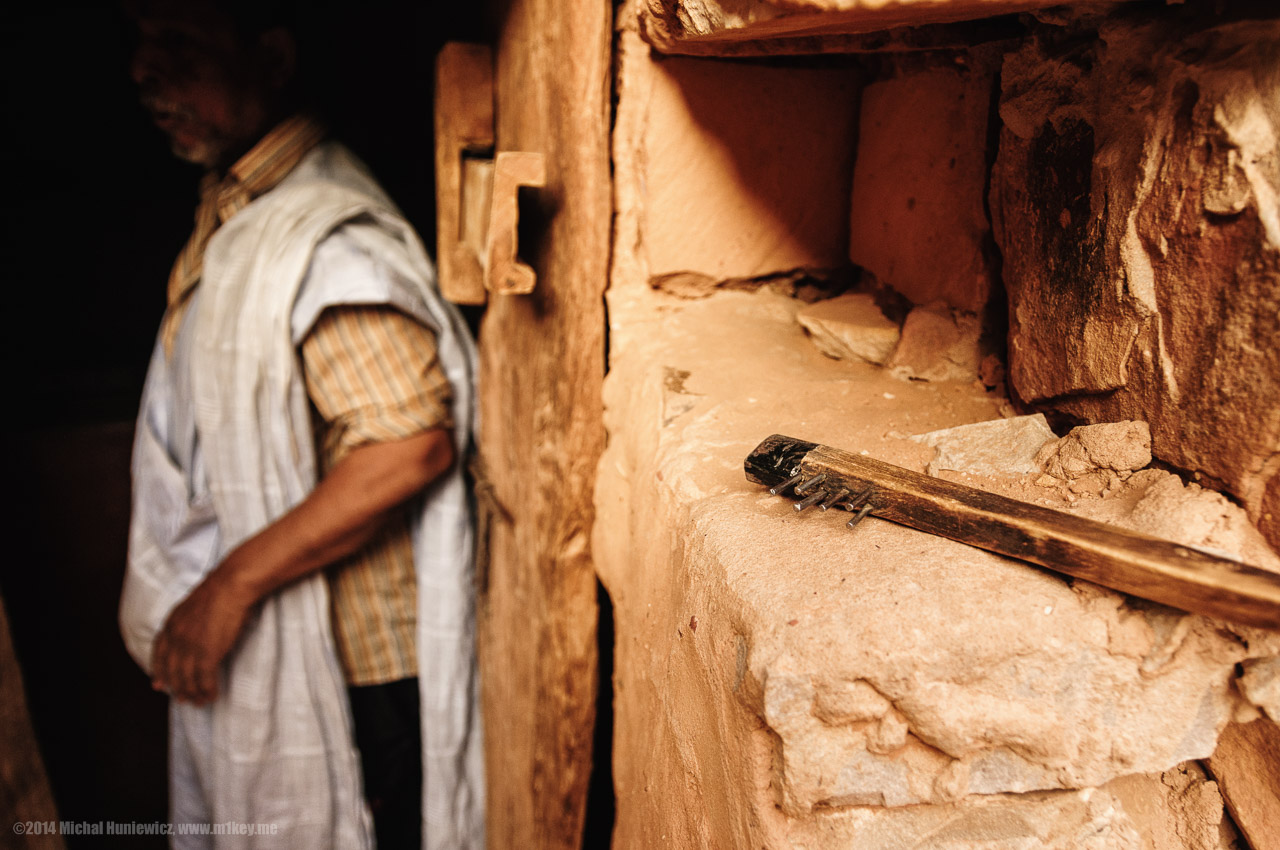
The libraries were traditionally run by elders, and they were free to use - having one was a symbol of status rather than a source of income.
This is not a toothbrush! It's an oldschool key; Ammar and I were both hopeless at using it though, couldn't get it to open the lock.
This is not a toothbrush! It's an oldschool key; Ammar and I were both hopeless at using it though, couldn't get it to open the lock.
ISO 200, 18mm, f/3.5, 1/500s.
Nothing Is Wasted in the Desert
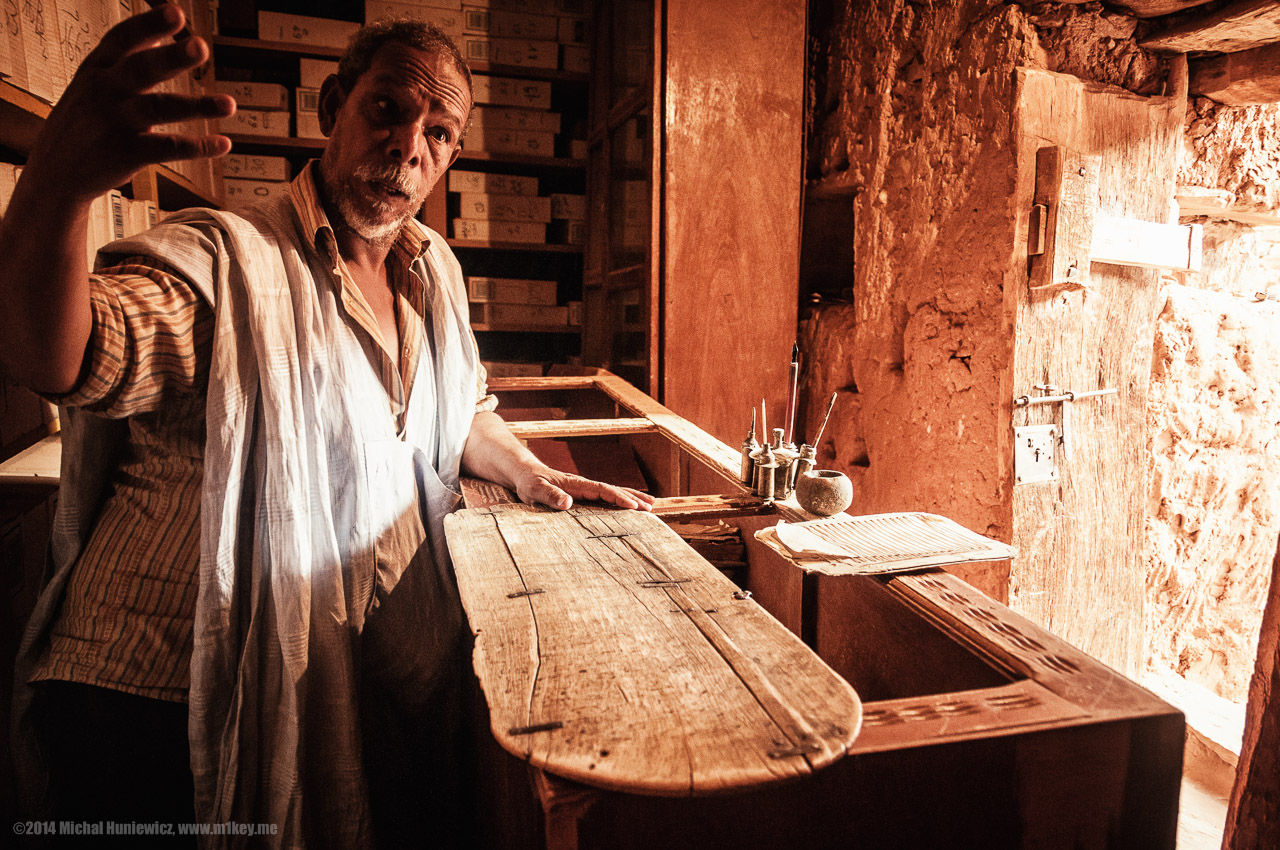
The libraries also contain documents describing trade-related activity from previous ages, when tens of thousands of camels would enter or leave the town daily. These days,
Chinguetti is quiet and desolate.
Please note the pens - they are placed in bullet shells. "Nothing is wasted in the desert".
Please note the pens - they are placed in bullet shells. "Nothing is wasted in the desert".
ISO 640, 18mm, f/3.5, 1/50s.
The Book
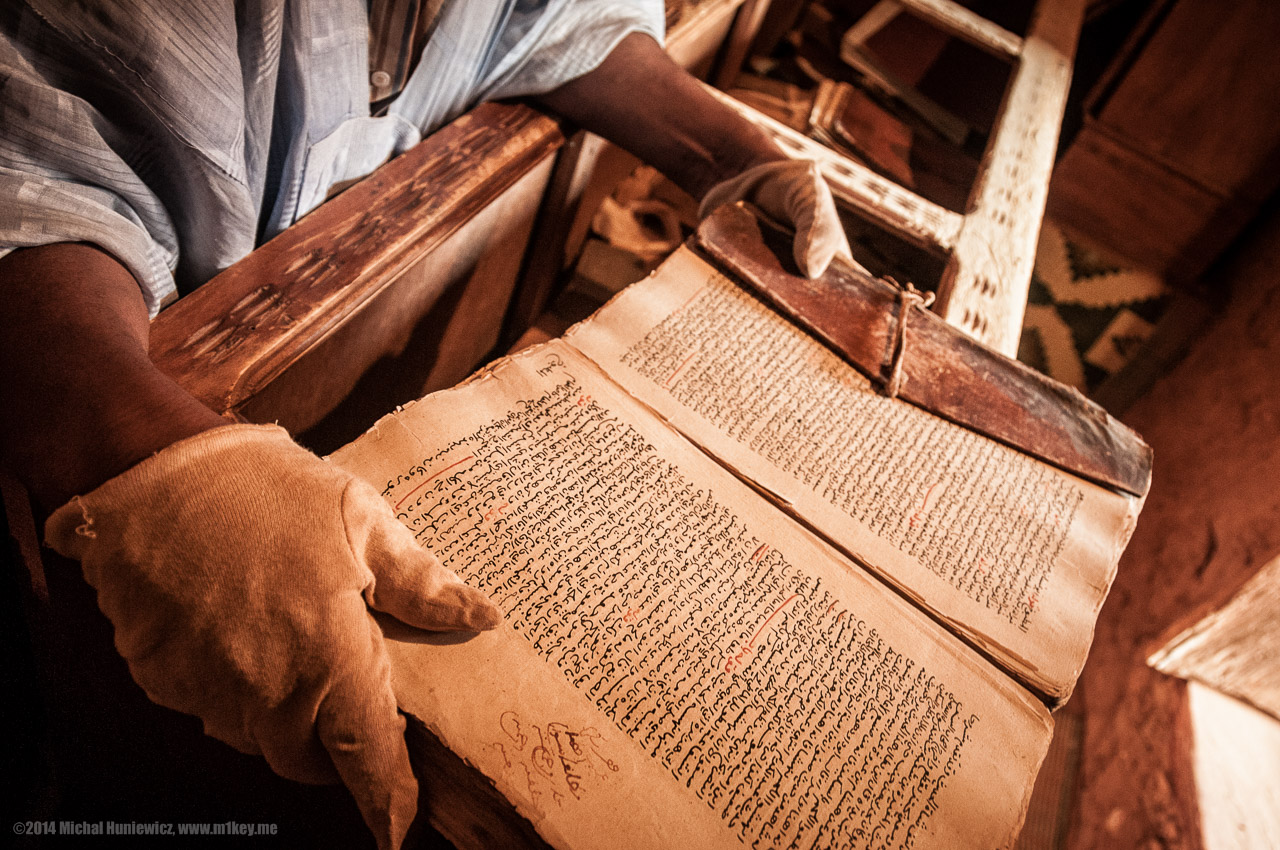
There are three kinds of books in the library, we were told. Written, copied, bought. This one had notes on its sides, made centuries ago.
The library, allegedly the only one in the world, contains a complete ancient copy of the works of Abū Hilāl al-'Askarī.
The library, allegedly the only one in the world, contains a complete ancient copy of the works of Abū Hilāl al-'Askarī.
ISO 640, 18mm, f/3.5, 1/50s.
For Pinching
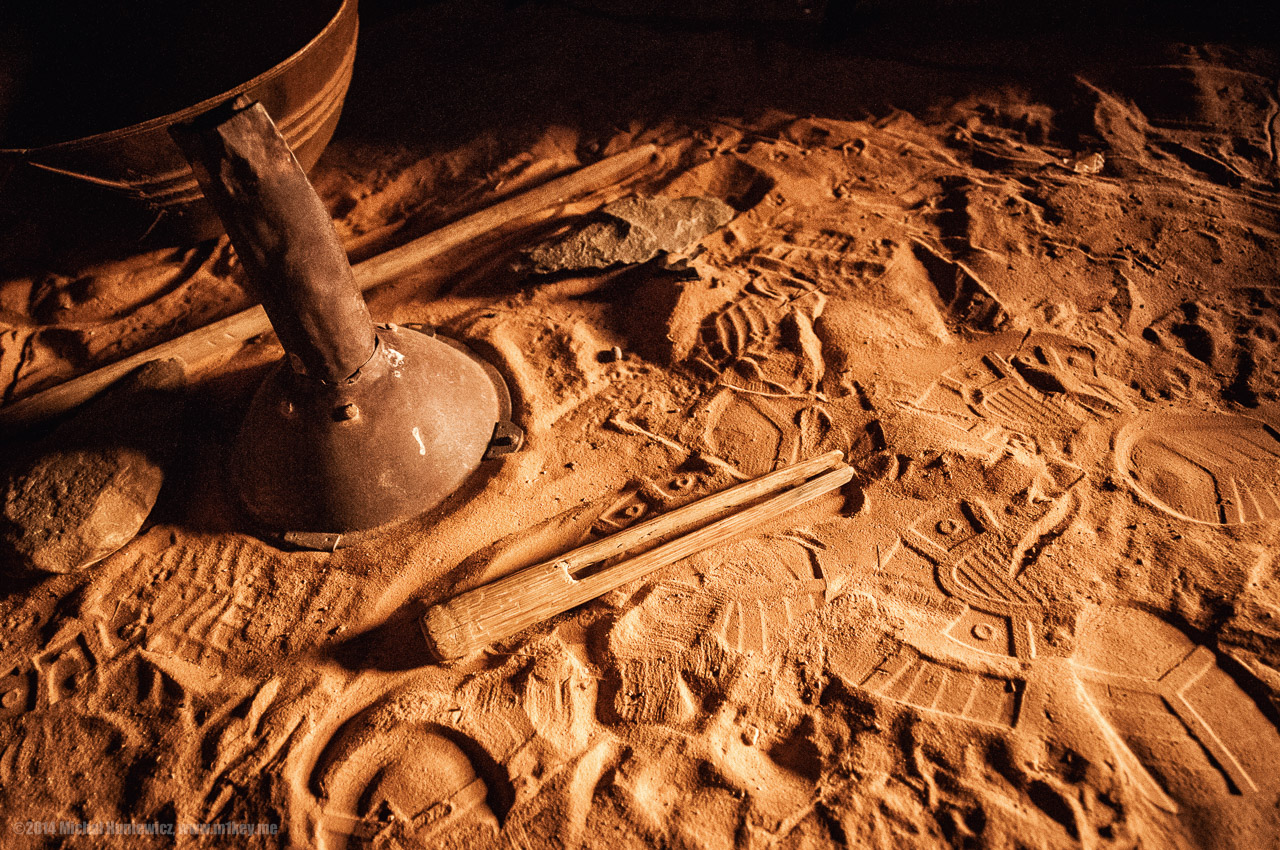
Until fairly recently, especially in rural areas, women were force-fed (leblouh), as fat was perceived as sexy and more "marryable" (shade in the summer, warmth in the winter?). This wooden device was allegedly used for pinching women
when they refused to eat.
ISO 3200, 18mm, f/3.5, 1/40s.
Librarian
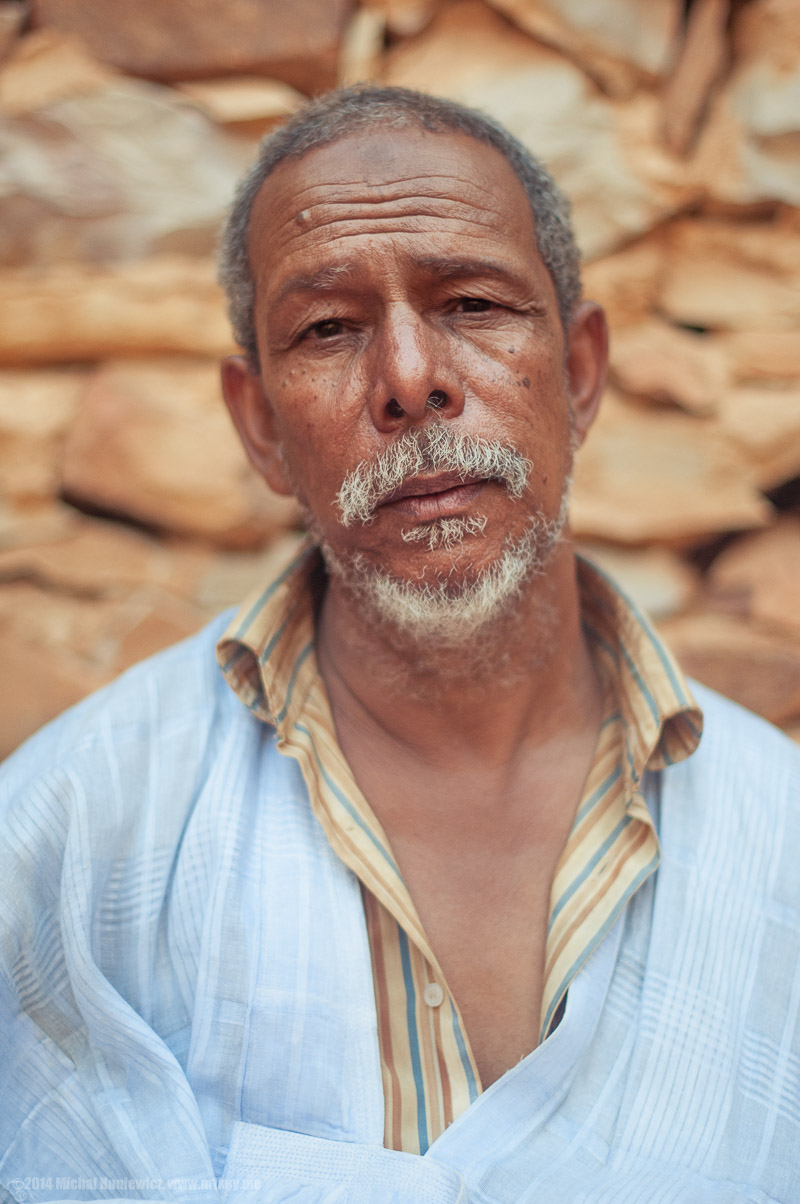
The librarian mentioned Al-Qaeda, telling us they were not really Muslim, and did not represent the true Islam. He also cracked a few jokes, and was overall a very nice guy.
He did stare, though, at the bottle I was drinking from - it was water with a peppermint teabag. As water inevitably becomes warm, it makes it more tasty (a trick I learnt from Michael Palin's book on the Sahara [2]).
Apparently, the water looked like whiskey, so perhaps he thought I was there in the seventh-most holiest site of Islam, in a Quranic library, slowly sipping Scotch from a plastic bottle!
He also sold us some postcards for a pretty good price, as opposed to the deranged salesman next door, whom, upon hearing his price, I insulted in Arabic, to Ammar's horror and surprise alike.
He also sold us some postcards for a pretty good price, as opposed to the deranged salesman next door, whom, upon hearing his price, I insulted in Arabic, to Ammar's horror and surprise alike.
ISO 200, 50mm, f/1.4, 1/800s.
Ahmed
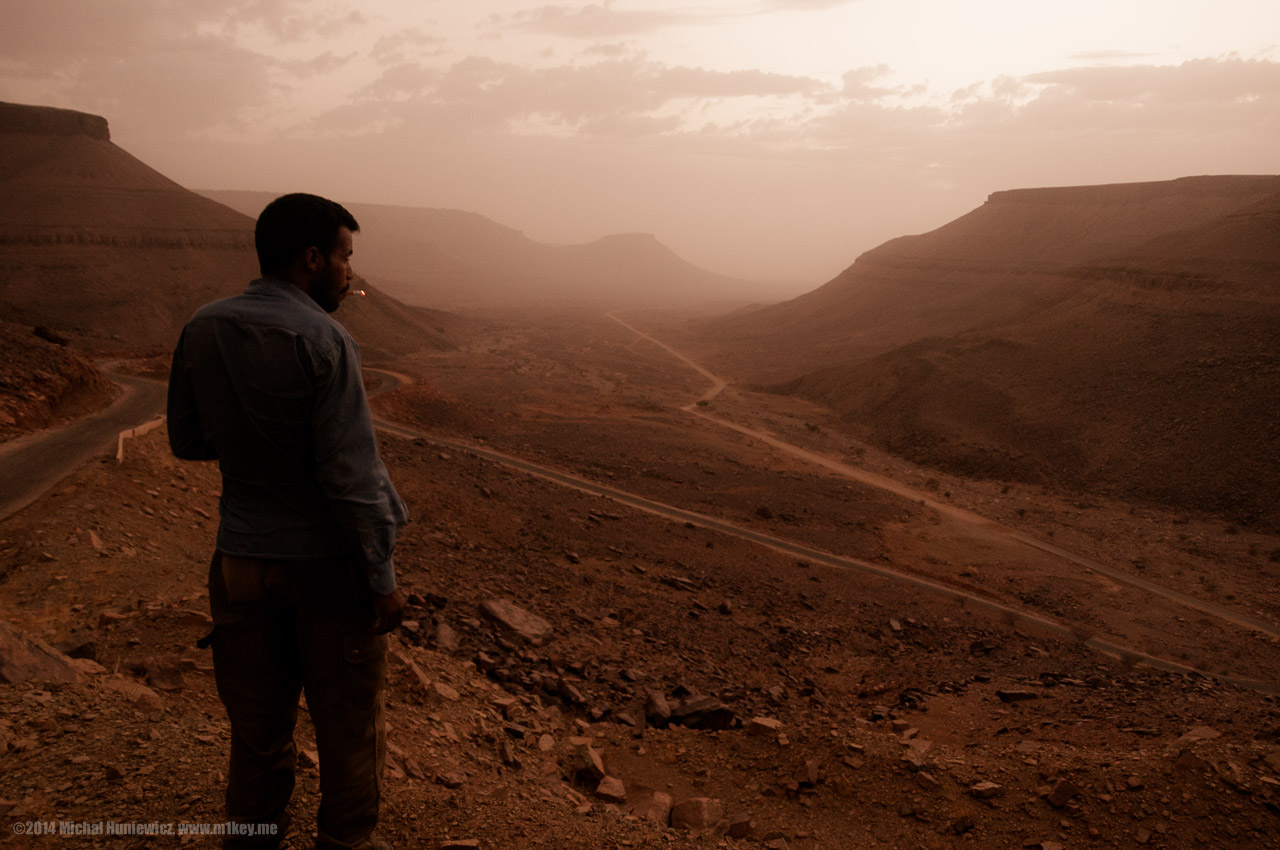
In Chinguetti, we missed yet another madhara (a Quranic school, something I wanted to photograph but always failed to for various reasons), and then it was time for us to return to Atar. In the photo, our driver Ahmed looking at the road ahead.
Ahmed was a very talented driver, and he actually said he was going to miss us.
Ahmed was a very talented driver, and he actually said he was going to miss us.
ISO 400, 18mm, f/3.5, 1/40s.
Waiting Room
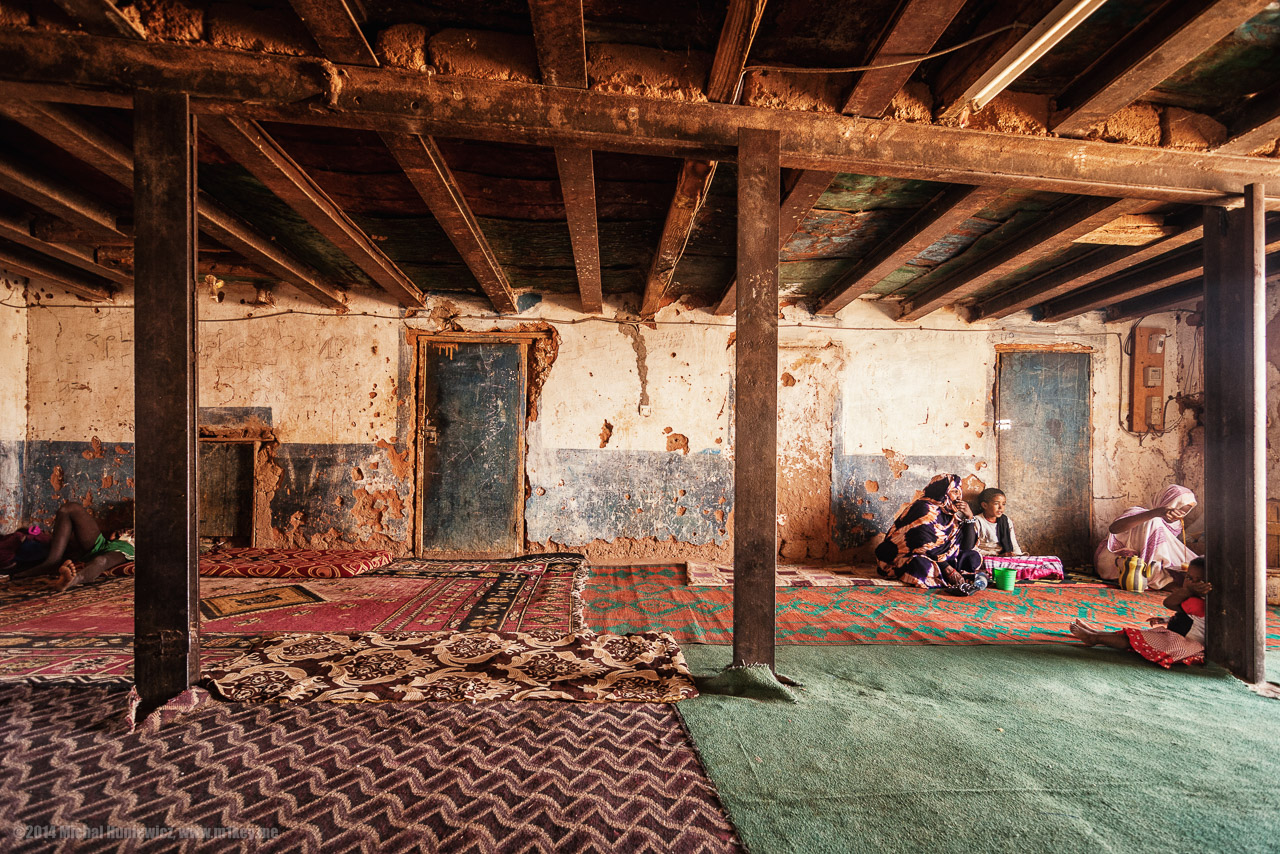
The following day the time came for the highlight of the trip and the reason for us to come to Mauritania in the first place. The cargo train across the Sahara!
First though, an endless wait in this room. It was supposed to be 7 hours, but turned out to be 11 hours. 11 hours there, with no air conditioning and no toilet.
On the other hand, we were offered tea by the girl on the right.
The Mauritania Railway train is a very long and very heavy cargo train transporting iron ore - the bedrock of Mauritanian economy - from a plant to the coast. Anyone can just hop on and travel on it for free.
On the other hand, we were offered tea by the girl on the right.
The Mauritania Railway train is a very long and very heavy cargo train transporting iron ore - the bedrock of Mauritanian economy - from a plant to the coast. Anyone can just hop on and travel on it for free.
ISO 200, 11mm, f/3.5, 1/25s.
Tuma
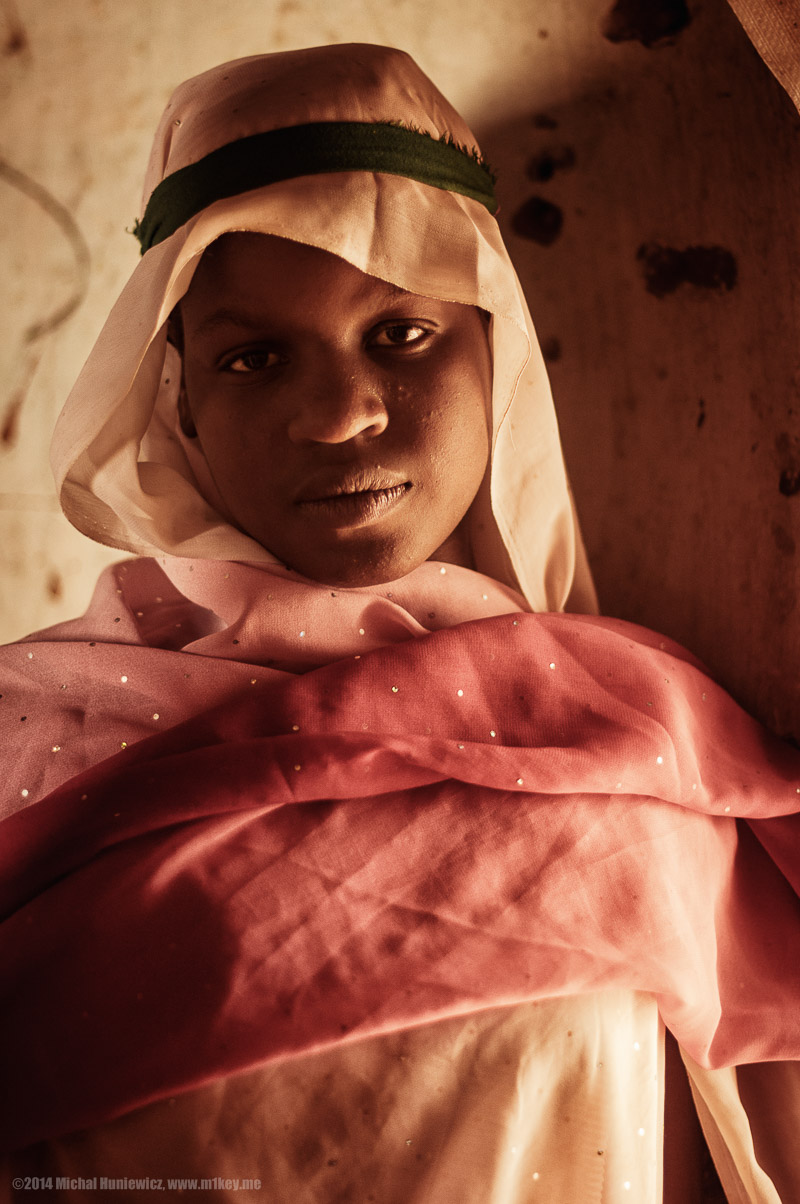
The girl who offered the tea was actually quite nice, and agreed to pose for me in several outfits. Ammar's presence allowed us to communicate.
ISO 200, 50mm, f/1.4, 1/250s.
Eating Apricots
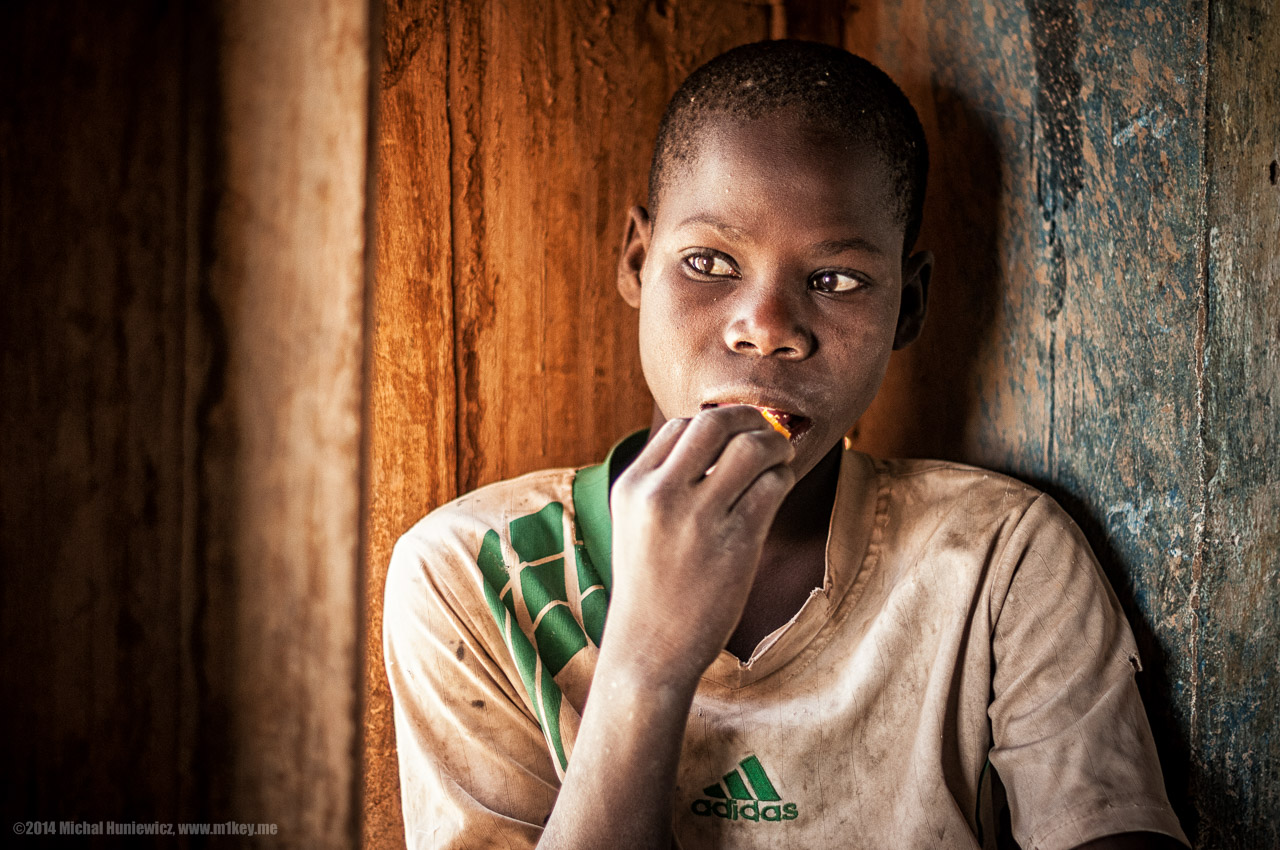
We shared some food with the locals - here, a boy is consuming an apricot he got from us.
Interestingly, many people whom we told we were going to take the train gave us their blessings. They were curious about our destination and where we were from.
Interestingly, many people whom we told we were going to take the train gave us their blessings. They were curious about our destination and where we were from.
ISO 200, 50mm, f/1.4, 1/250s.
Messi
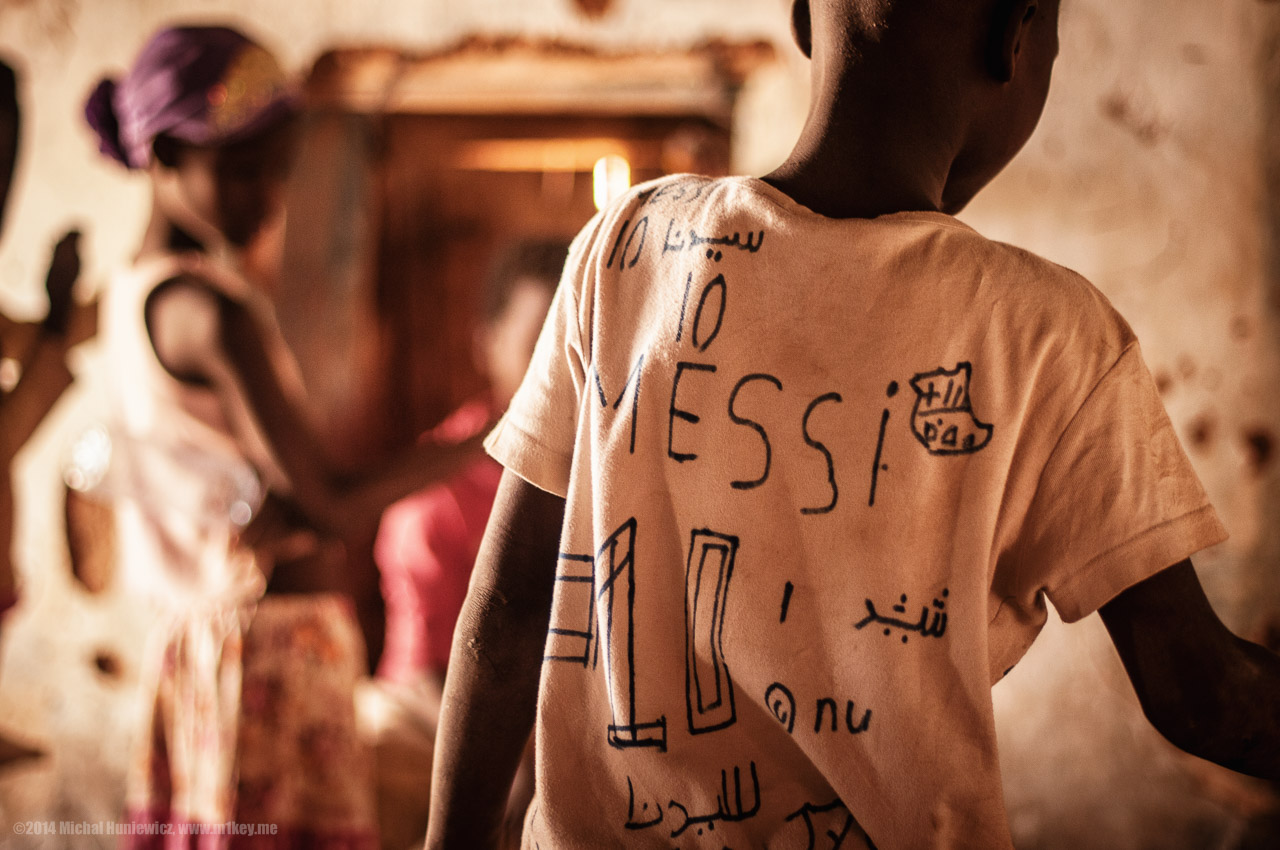
The apricots were promptly stolen by this troubled youth, whom everyone around hated. He would soon be briefly tortured
by one of the men, who lost his patience, to everyone's genuine joy and relief.
ISO 200, 50mm, f/5.6, 1/125s.
Choûm
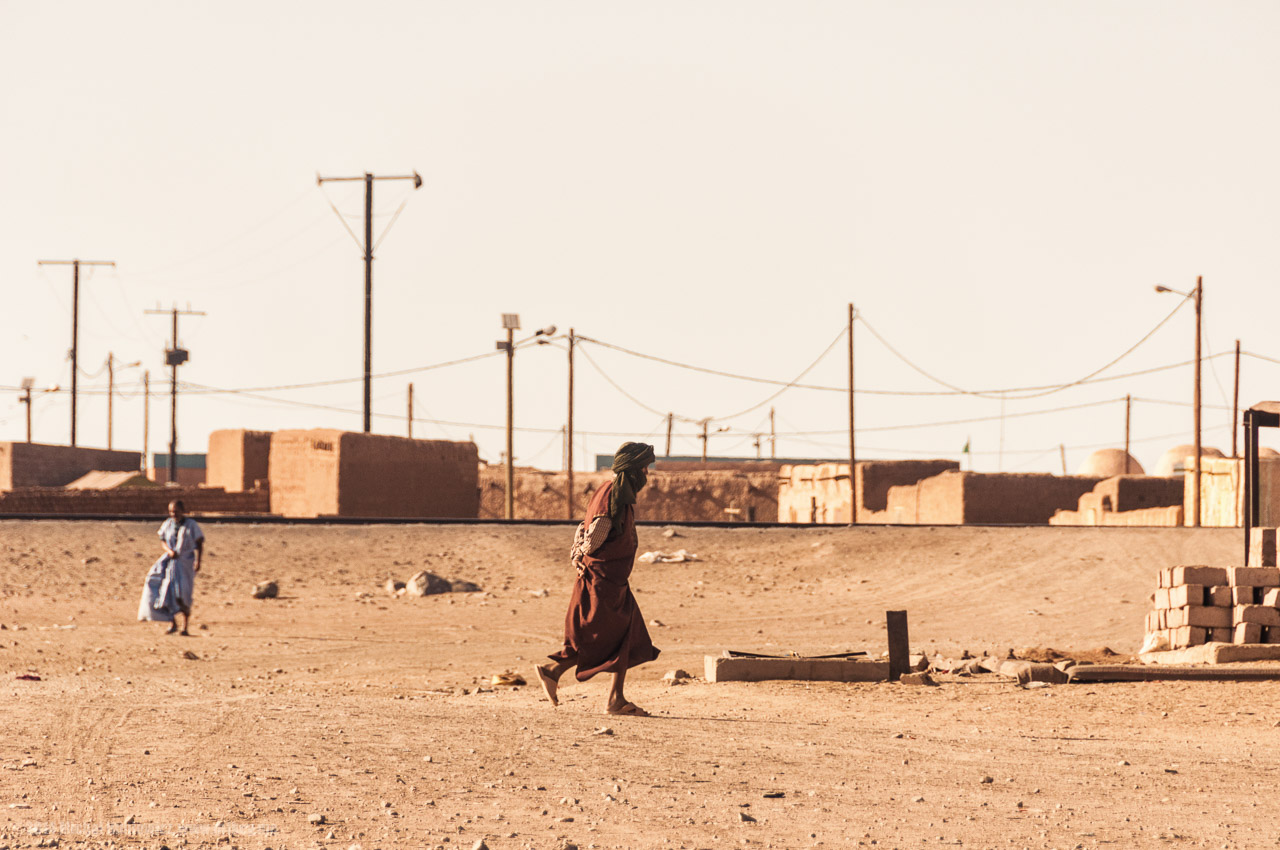
Choûm is pretty basic and rather hopeless. 11 hours there were quite challenging - Ammar engaged in several theological debates, and was offered to play with a grown-up woman's breasts; I left the room to have a look around
(and give them some privacy in case Ammar were to reconsider her offer...).
ISO 200, 200mm, f/5.6, 1/640s.
We Spent 11 Hours There
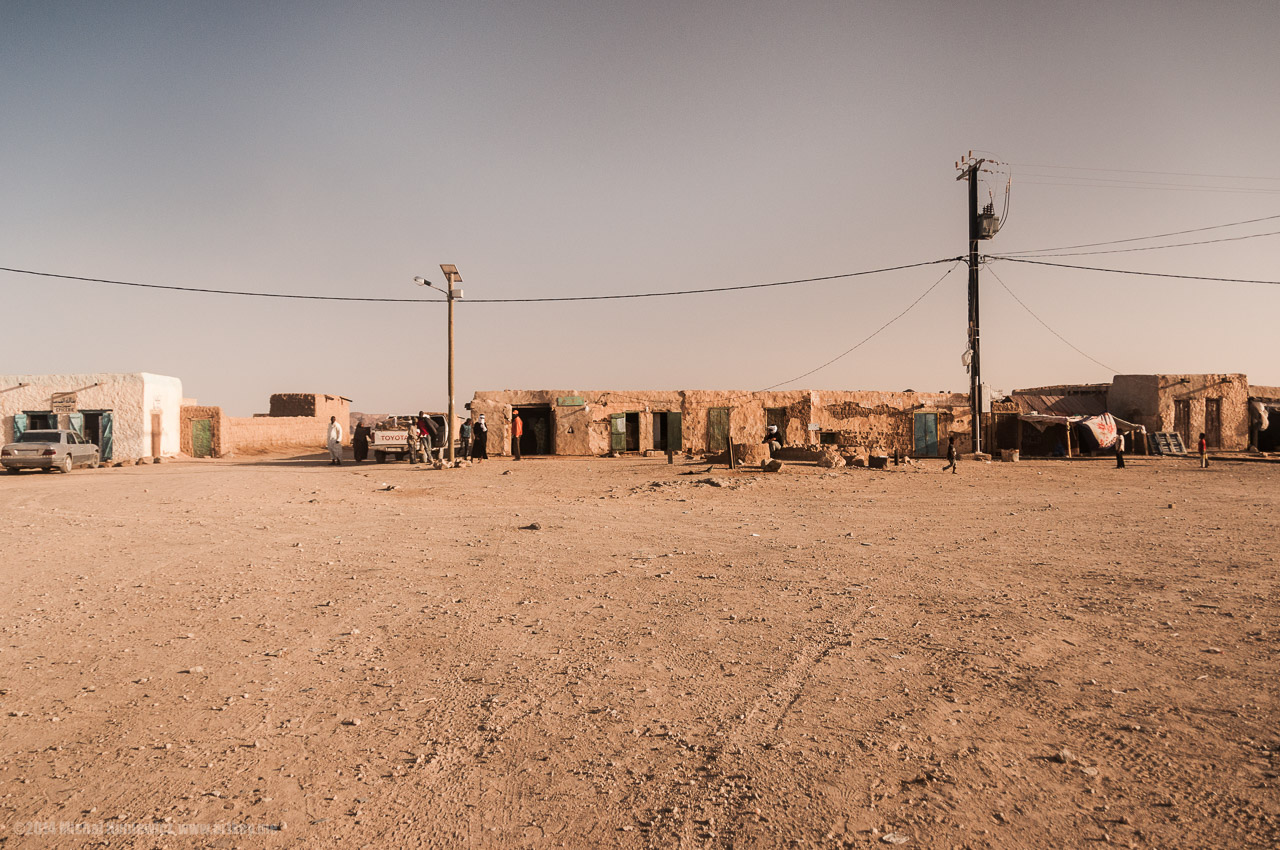
The entrance where the guy wearing red is standing - that's the waiting room.
ISO 200, 18mm, f/3.5, 1/1000s.
Little Mosque

Little mosque among Choûm buildings.
Vast majority of the population of Mauritania are Muslim, but various pagan beliefs and superstitions are still alive, such as the fear of walking barefoot in certain places, in case someone were to curse your footprint. The Tuaregs have always covered themselves with amulets; there are reports of them fearing the evil look of foreign women.
When the French came to the Sahara, to its inhabitants French technical superiority was sorcery - a plane was a tent that flies, and a car was a prison of a djinn that made the car go.
Vast majority of the population of Mauritania are Muslim, but various pagan beliefs and superstitions are still alive, such as the fear of walking barefoot in certain places, in case someone were to curse your footprint. The Tuaregs have always covered themselves with amulets; there are reports of them fearing the evil look of foreign women.
When the French came to the Sahara, to its inhabitants French technical superiority was sorcery - a plane was a tent that flies, and a car was a prison of a djinn that made the car go.
ISO 200, 95mm, f/9.0, 1/200s.
Football
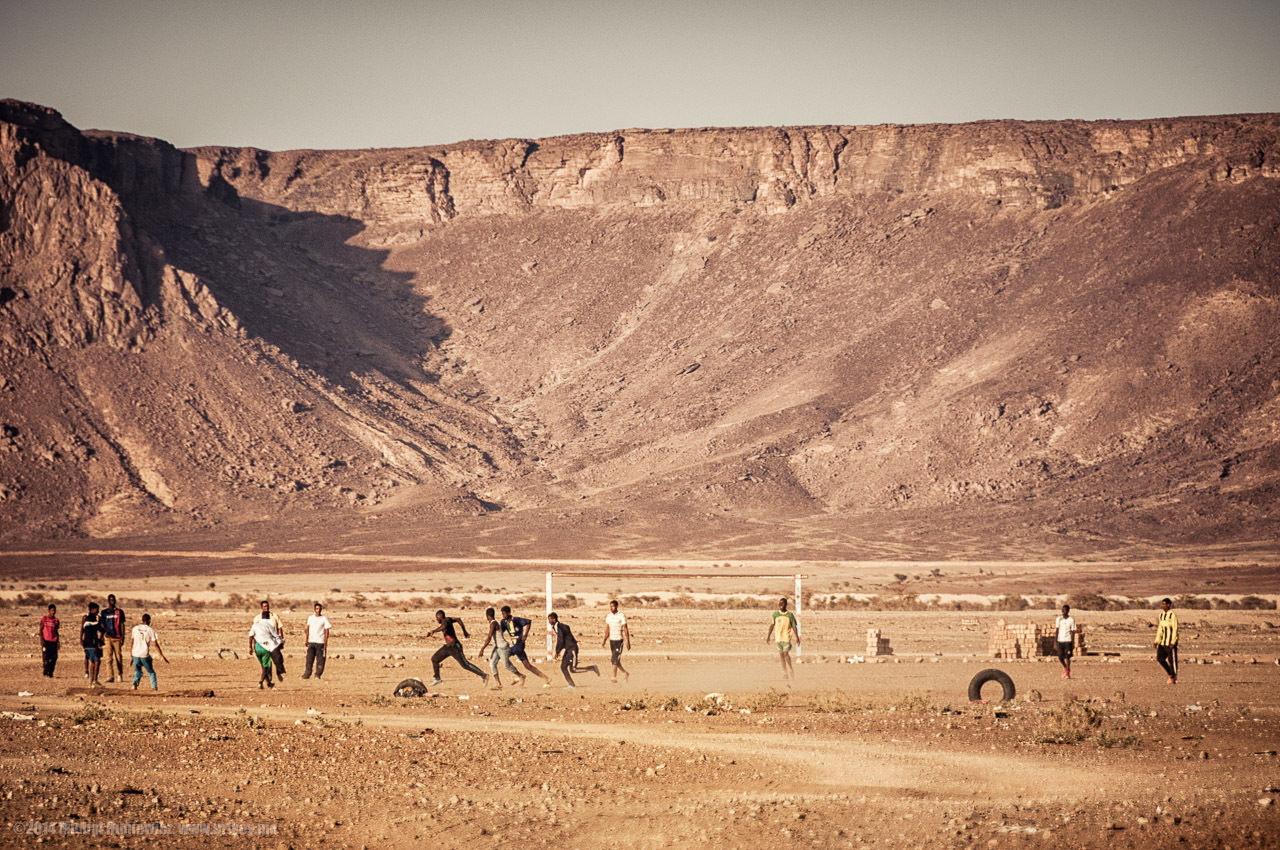
In the colonial times, the French built a tunnel in those mountains so that the train wouldn't have to go through the Western Saharan territory.
2 km through solid granite. The tunnel is currently disused.
Allegedly, this venture is referred to as a "monument to European stupidity in Africa". [4]
Allegedly, this venture is referred to as a "monument to European stupidity in Africa". [4]
ISO 200, 200mm, f/5.6, 1/320s.
BLAH
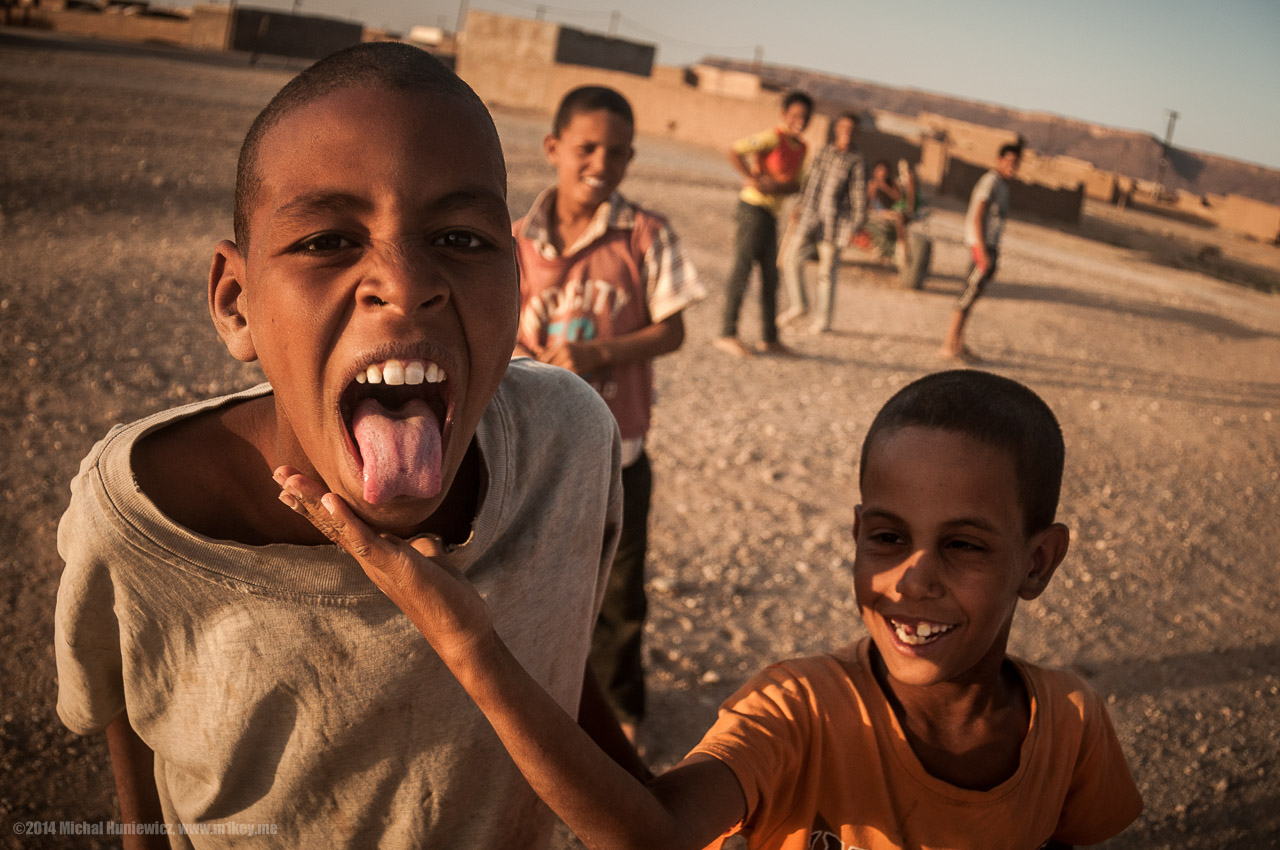
I briefly joined the kids who were playing football, and afterwards they gave me a ride on the dray you can see in the background.
ISO 200, 18mm, f/3.5, 1/320s.
Tracks
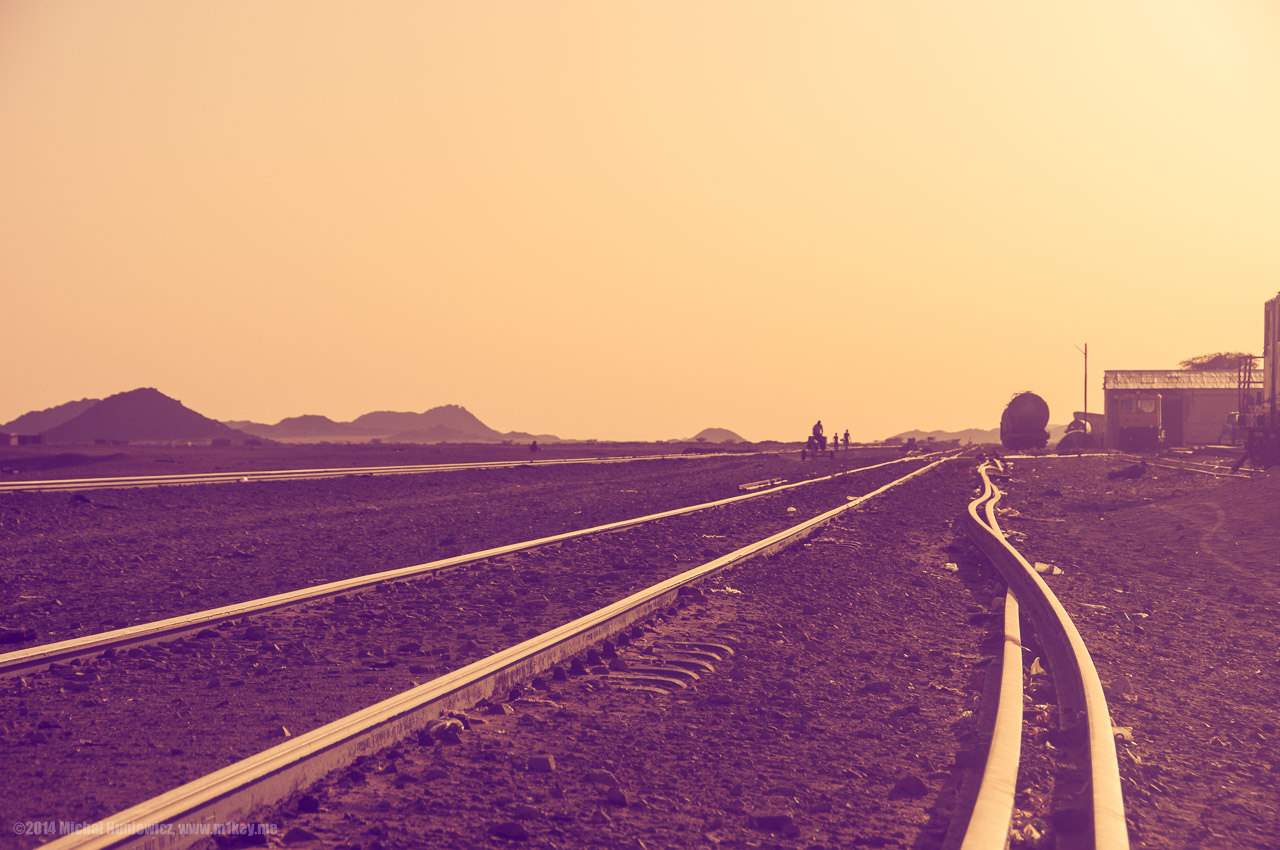
We began to worry the train would be late. There were supposed to be three trains a day going out of Choûm (according to Michael Palin and what I had seen on the Internet), but, for some reason,there was only one. I had made a lot of preparations
to take an amazing sunset shot from the train with those mountains in the background, but it soon became obvious the train wouldn't arrive before dark. Well, mission failed!
Later, there was an argument among other passengers and the owner of a local store - apparently, they were upset because he had let Ammar and me buy too much water... We never got to the bottom of that, and no one complained to us personally.
Later, there was an argument among other passengers and the owner of a local store - apparently, they were upset because he had let Ammar and me buy too much water... We never got to the bottom of that, and no one complained to us personally.
ISO 200, 75mm, f/9.0, 1/400s.
Tuma #2
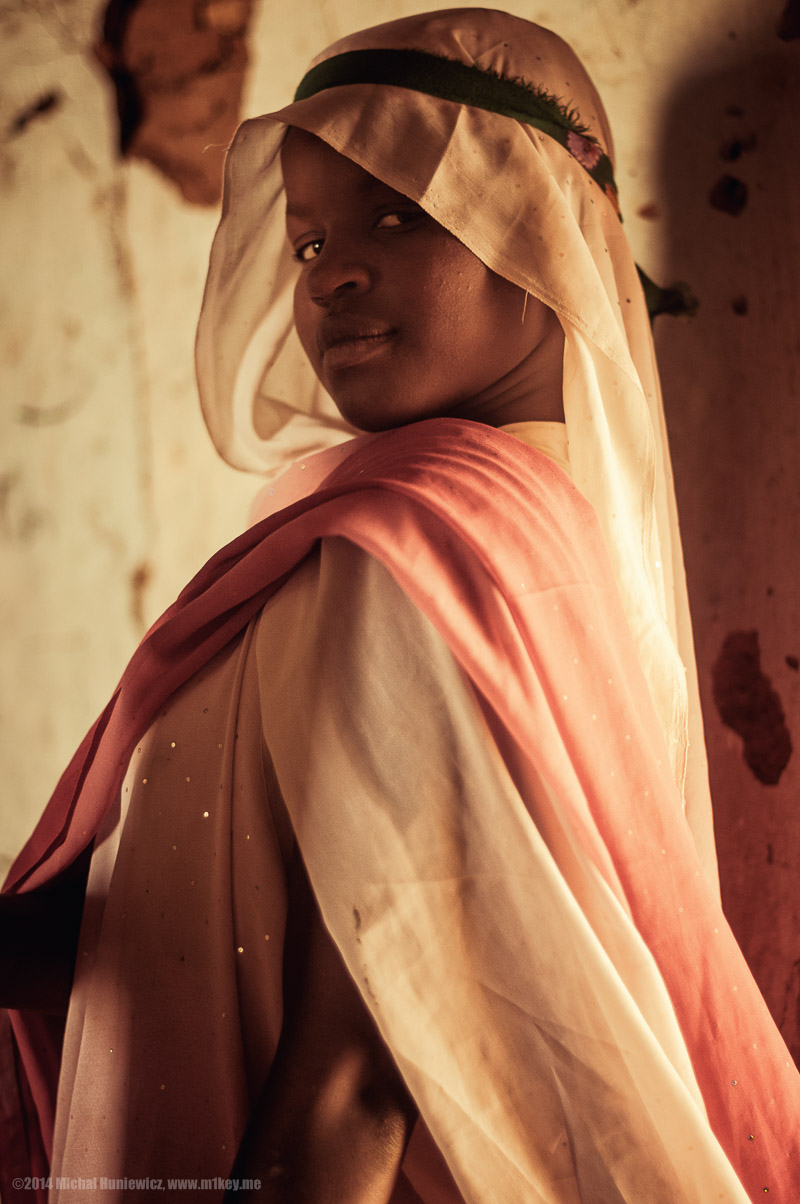
In the past, the highest act of love in some parts of the Sahara was to kill a camel, and offer a piece of raw meat to your paramour, saying
"I cut out a steak from the most tender part and stuck it on the end of my lance"... "To offer a very red steak, still steaming with life,
to the woman one adores... what a beautiful expression of love."
When the train finally arrived at 11PM, 5 hours late, I said goodbye to Tuma, and would never see her again.
When the train finally arrived at 11PM, 5 hours late, I said goodbye to Tuma, and would never see her again.
ISO 200, 50mm, f/1.4, 1/200s.
Ah, There They Are
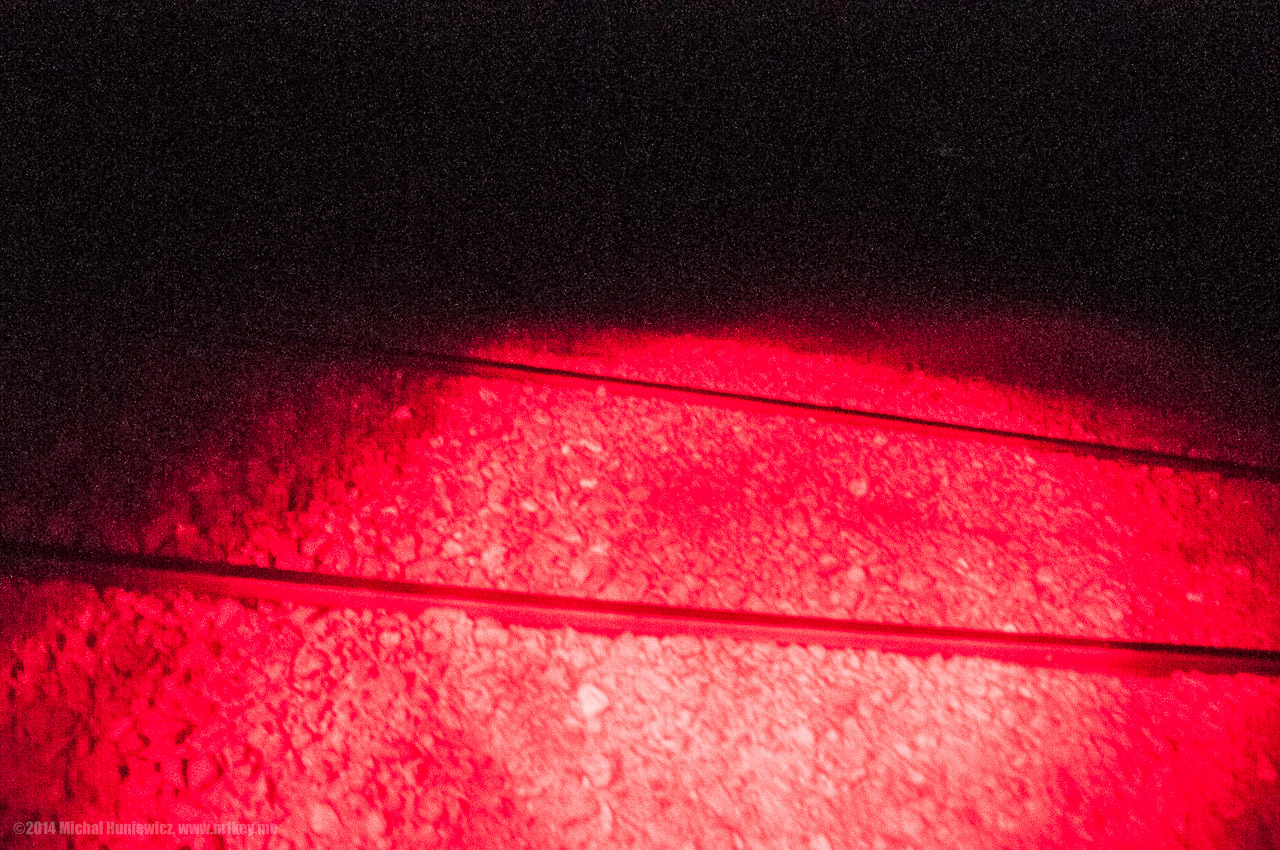
A man, who didn't say a word to us, took our baggage, put it in an old Mercedes, and gestured for us to get in. He chanted some sort of Islamic prayer in the car,
and drove away from Choûm into complete darkness, off road, into the Sahara. It was somewhat tense, a bit of a Black Hawk Down moment, and I texted one of my friends in case we were being kidnapped.
He stopped the car, took our baggage out, and drove away, leaving us in the middle of nowhere. As we were standing there, perplexed, I decided to use my torch to have a look around, and found this - the train tracks! Maybe we were not being kidnapped, after all.
He stopped the car, took our baggage out, and drove away, leaving us in the middle of nowhere. As we were standing there, perplexed, I decided to use my torch to have a look around, and found this - the train tracks! Maybe we were not being kidnapped, after all.
ISO 6400, 18mm, f/3.5, 0.5s, hand-held.
The Milky Way
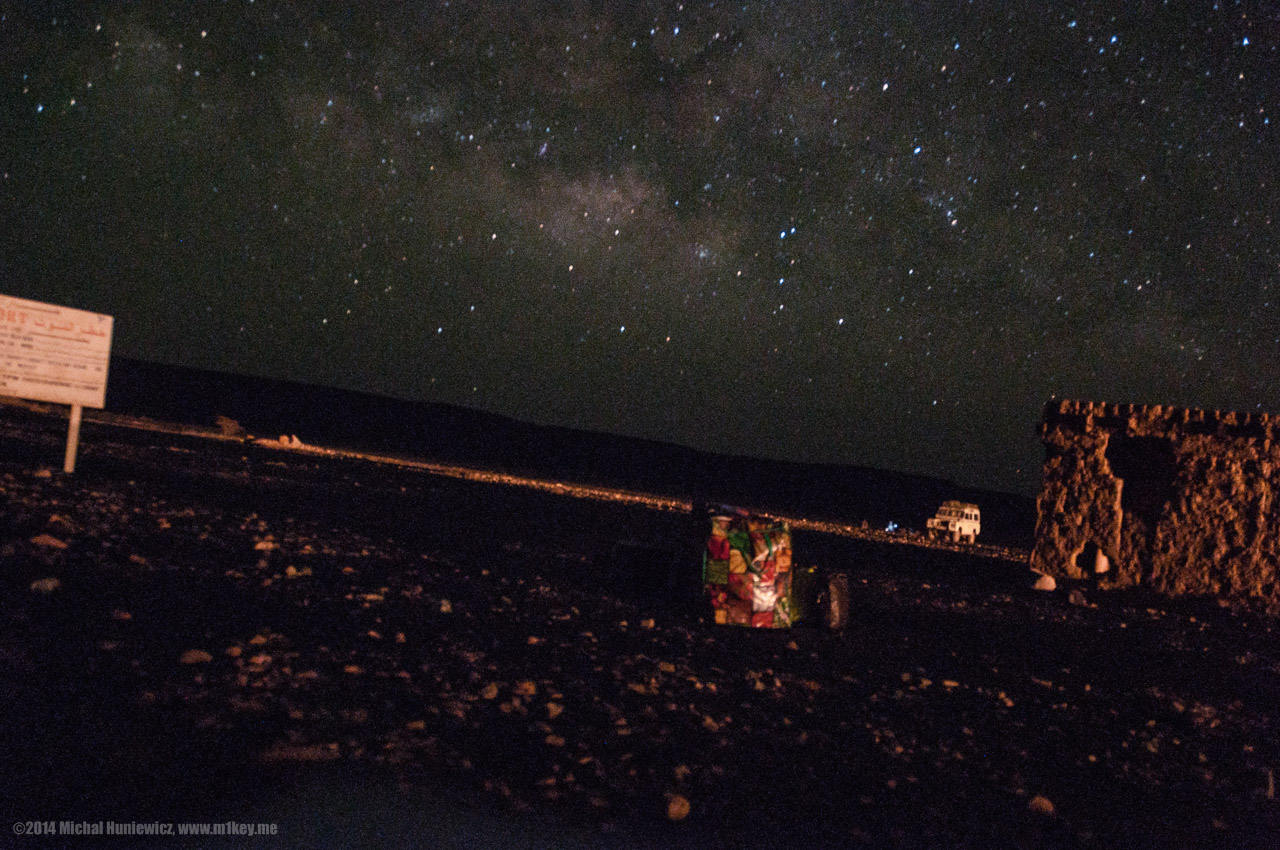
Soon enough, our ears picked up hushed voices from afar. I attempted this meh shot of the night sky, when more cars began to come, as other passengers were being brought over to board the train.
It had begun!
ISO 400, 18mm, f/3.5, 30s, resting on something.
At Last, the Train
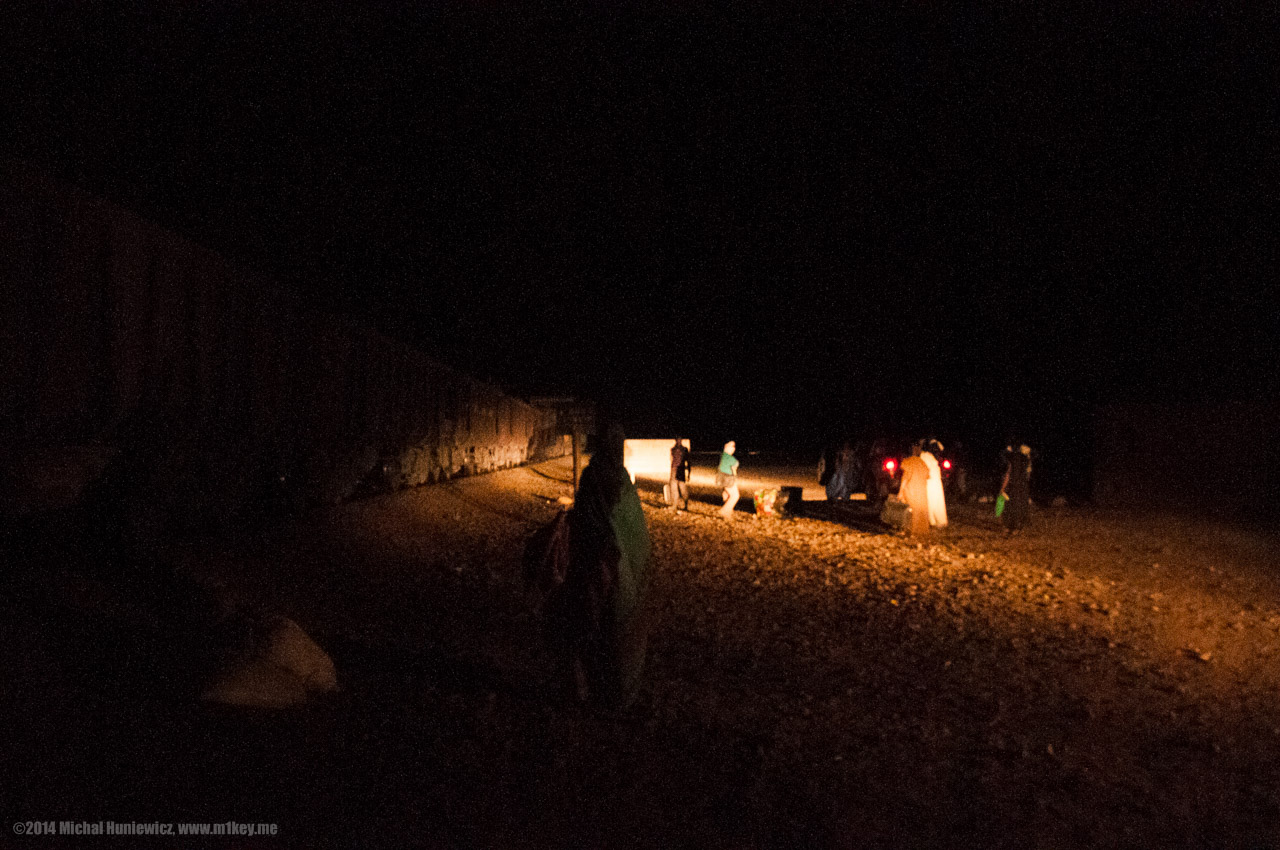
At last, the train came! This was supposed to be more than one hour before sunset to give me enough time to take the shot I had dreamt of taking, but never mind. I was ecstatic!
People rushed to board the train, or rather to storm it; it felt like the siege of Constantinople!
Ammar: [It was] absolute pandemonium. People placed themselves where they thought the train would stop, but it's so long/heavy that with breaks it's hard to control that. We ended up having to run furiously to get to one of the ore wagons that didn't have someone in it. That's where I wrenched my arm (and suspect hurt my back until now) lifting our stuff onto the wagon. It's also where we trod on those boxes of supplies and broke some, which the guy wasn't happy about (but we ignored him). We then shook each other's hand saying we had made it, thinking we'd done the hard part. But then the train started moving and we choked and froze, etc. I thought I would die of hypothermia, but staring up at the Milky Way seemed to keep me going. It was mesmerising to me.
All aboard crazy train!
Someone who appeared from nowhere and whose name or identity we never learnt gave us some advice on the ride, and helped us put our bags on top of the wagon. The sky was just stunning.
Ammar: [It was] absolute pandemonium. People placed themselves where they thought the train would stop, but it's so long/heavy that with breaks it's hard to control that. We ended up having to run furiously to get to one of the ore wagons that didn't have someone in it. That's where I wrenched my arm (and suspect hurt my back until now) lifting our stuff onto the wagon. It's also where we trod on those boxes of supplies and broke some, which the guy wasn't happy about (but we ignored him). We then shook each other's hand saying we had made it, thinking we'd done the hard part. But then the train started moving and we choked and froze, etc. I thought I would die of hypothermia, but staring up at the Milky Way seemed to keep me going. It was mesmerising to me.
All aboard crazy train!
Someone who appeared from nowhere and whose name or identity we never learnt gave us some advice on the ride, and helped us put our bags on top of the wagon. The sky was just stunning.
ISO 6400, 18mm, f/3.5, 1/30s, hand-held.
Good Morning, Sahara
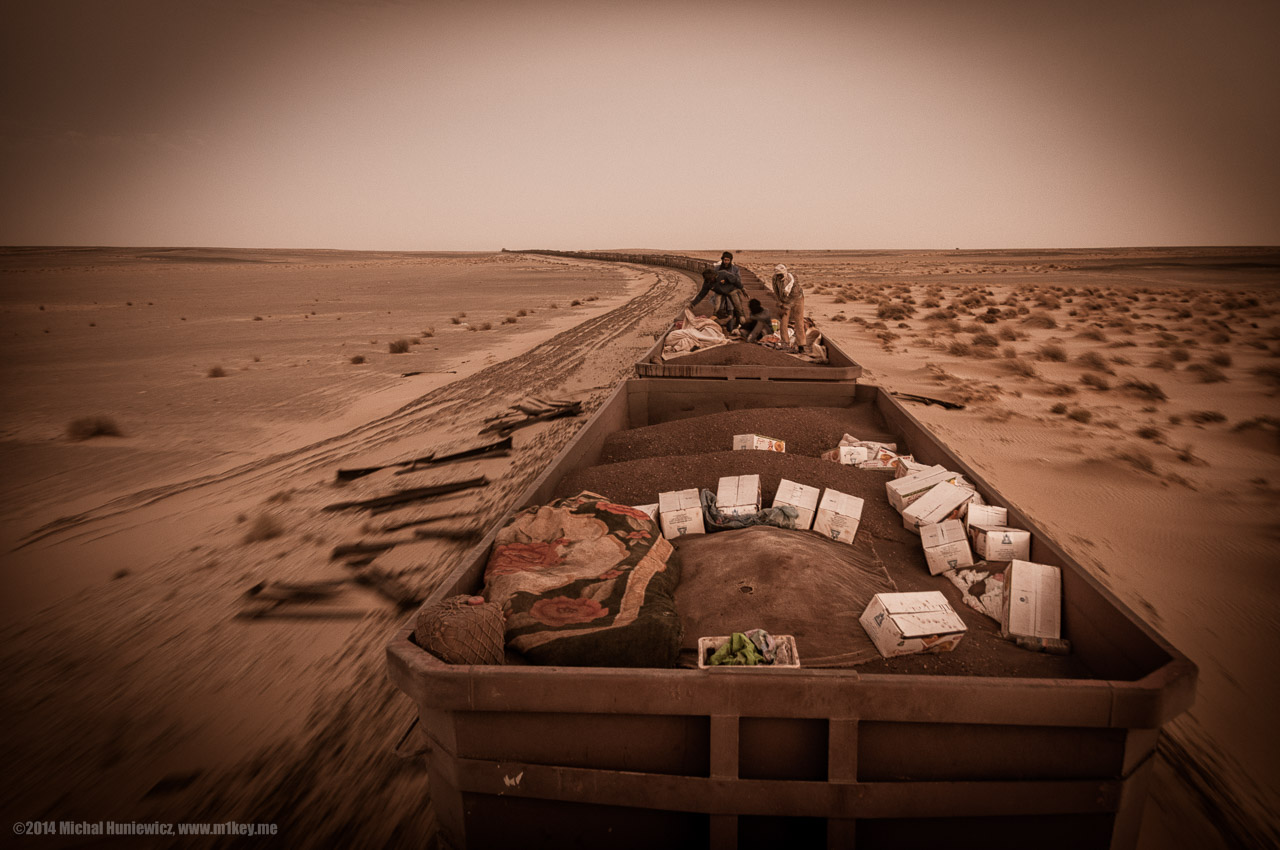
I think I was the first person to wake up (for once).
This is where we spent the whole night. We had to dig holes in the iron ore, against the edges of the wagon, to sleep in. It was freezing. I woke up in the middle of the night, checked if Ammar was still alive (he seemed to be), and tugged dirty underwear under my jumper, and put socks on my hands, to retain some warmth.
If you are travelling the other way round, from the coast to the iron ore plant, it might be warmer at night, as the then empty wagon will shield you from the wind. Ammar pointed out it could be more bumpy though, as there is no weight to keep the wagons from jolting.
This is where we spent the whole night. We had to dig holes in the iron ore, against the edges of the wagon, to sleep in. It was freezing. I woke up in the middle of the night, checked if Ammar was still alive (he seemed to be), and tugged dirty underwear under my jumper, and put socks on my hands, to retain some warmth.
If you are travelling the other way round, from the coast to the iron ore plant, it might be warmer at night, as the then empty wagon will shield you from the wind. Ammar pointed out it could be more bumpy though, as there is no weight to keep the wagons from jolting.
ISO 360, 18mm, f/3.5, 1/15s.
Sunrise, Almost
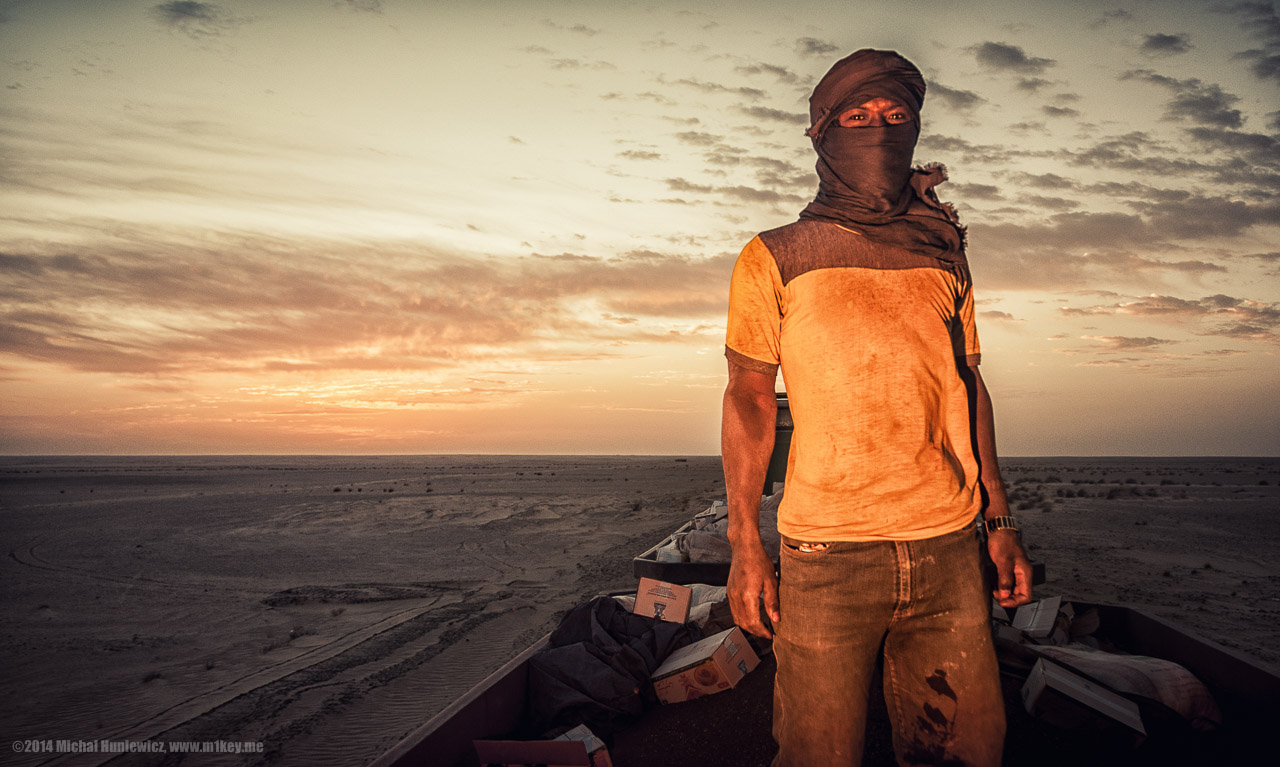
Some of these men do the entire route - they travel from M'Haoudat to Nouadhibou, which 704 km long. We only did 460 km, but as the train is really slow, it takes ages -
our ride was about 14 hours.
In the Sahara, you would address a stranger in the plural - one theory is that you are also addressing the guardian angel. [6, p. 54]
In the Sahara, you would address a stranger in the plural - one theory is that you are also addressing the guardian angel. [6, p. 54]
ISO 200, 18mm, f/3.5, 1/160s.
Good Morning, Ammar
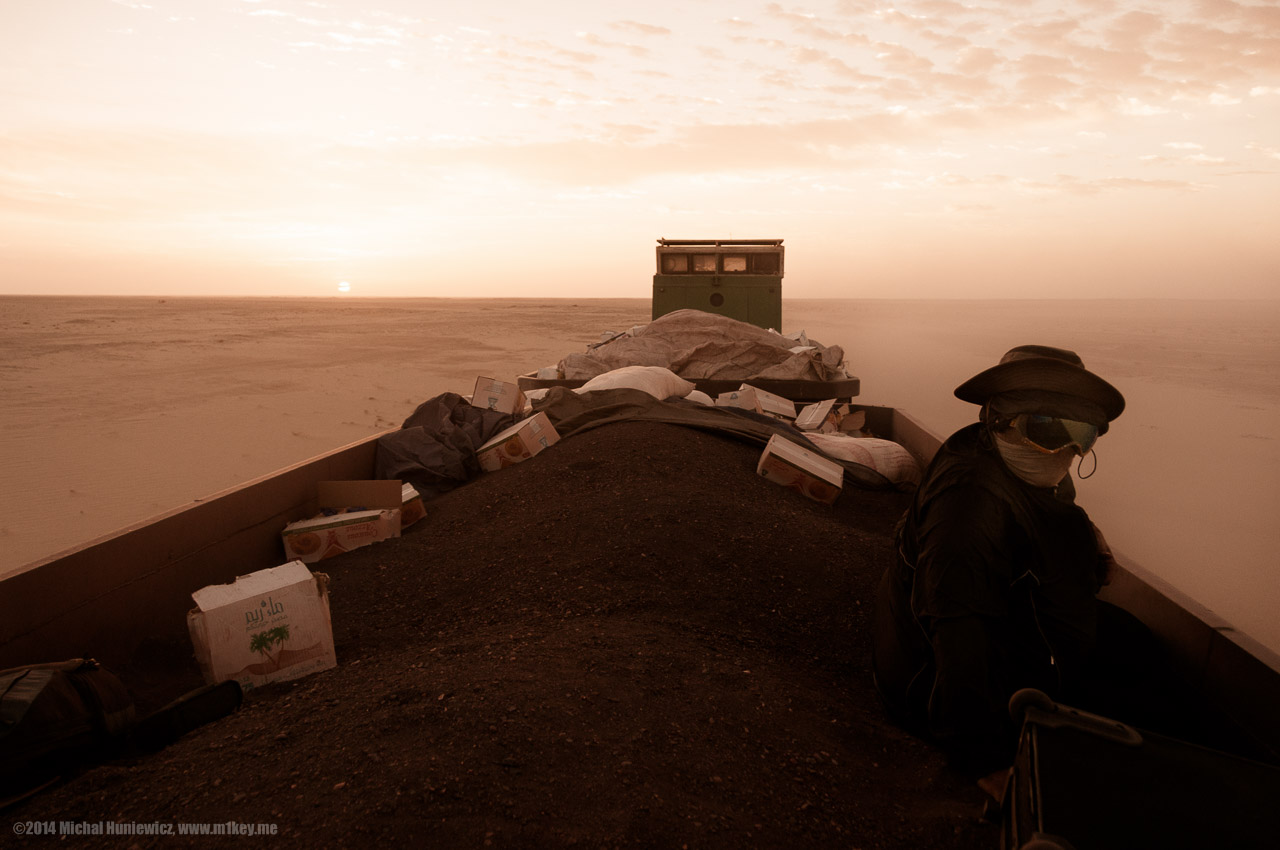
Ammar soon woke up, too. Occasionally, while never crossing the mine-infested border with Western Sahara, we would get Moroccan network reception, and Ammar
managed to download and read his work email. Around us was nothing, and there was still a lot of choking dust in the air.
Each of these hopper cars carries about 84 tons of iron ore. [3]
Each of these hopper cars carries about 84 tons of iron ore. [3]
ISO 200, 18mm, f/3.5, 1/160s.
Camels
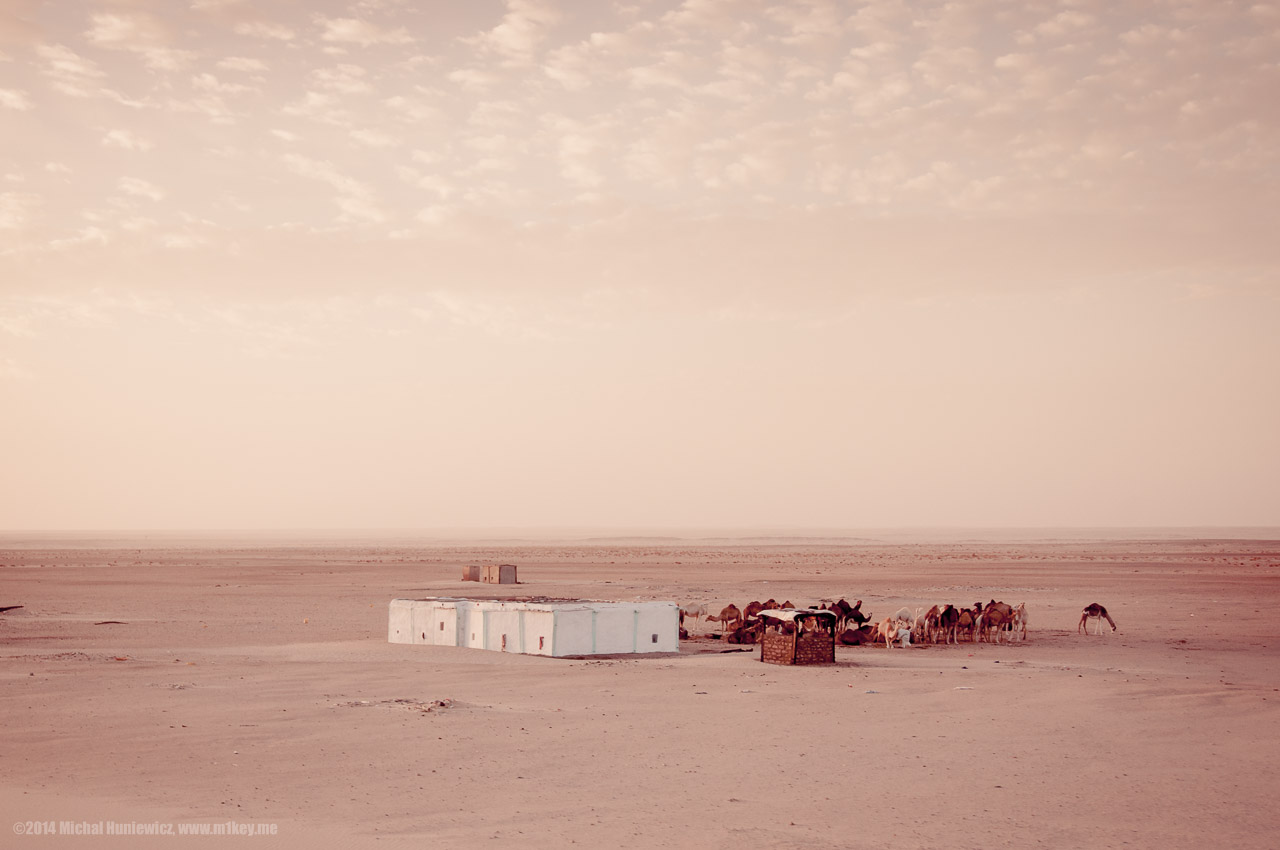
The place looked rather desolate, but then we saw this well and camels.
ISO 200, 38mm, f/8.0, 1/125s.
Iron Ore
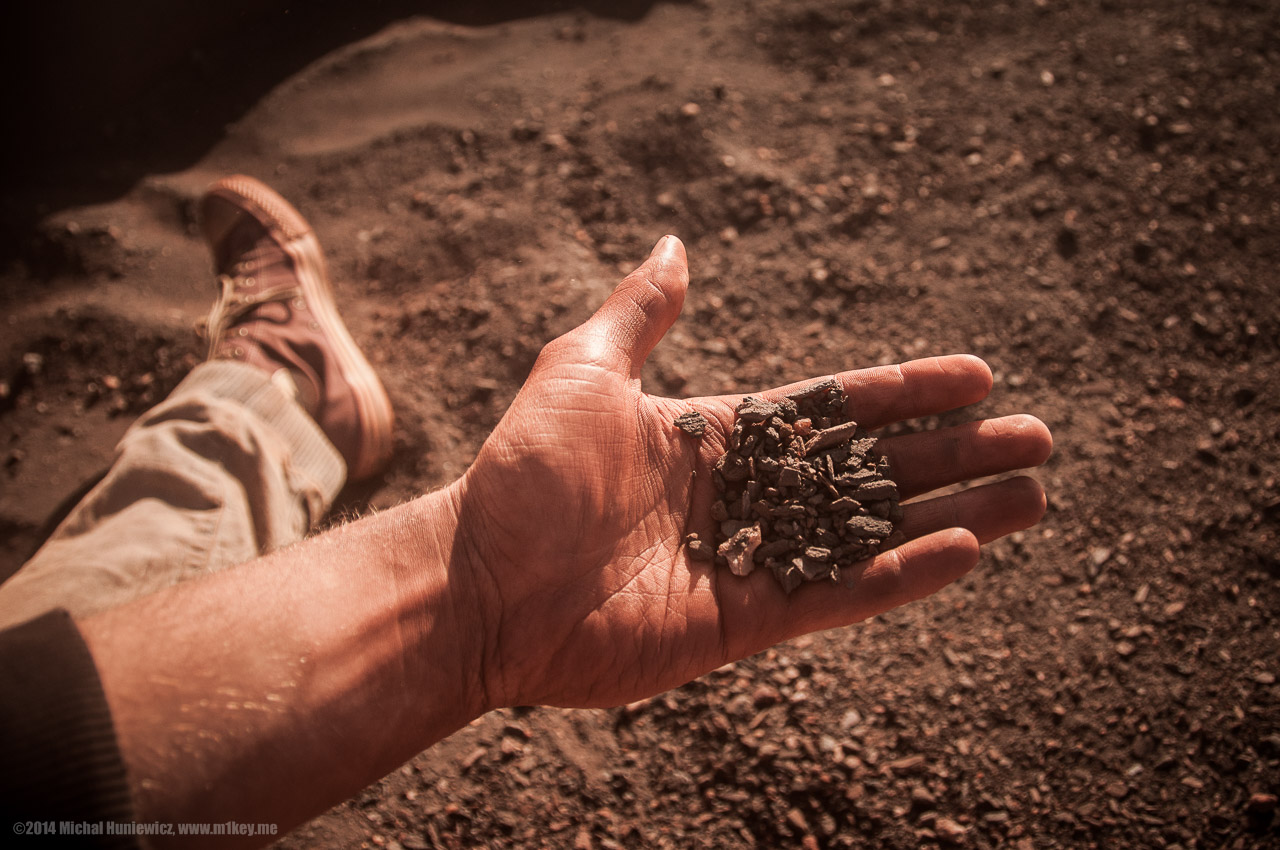
This is the iron ore that fills the wagons when the train is going westward towards the coast. It makes it really hard to breathe, so a scarf on your face is a must.
The fine dust gets inside your baggage, everywhere. We had refuse sacks to hide stuff inside, but it didn't really work, as they were completely torn by the end of the train journey.
There is also a possibility of travelling in a rather raw passengers carriage, and that you have to pay for.
There is also a possibility of travelling in a rather raw passengers carriage, and that you have to pay for.
ISO 200, 18mm, f/3.5, 1/2000s.
Sahara
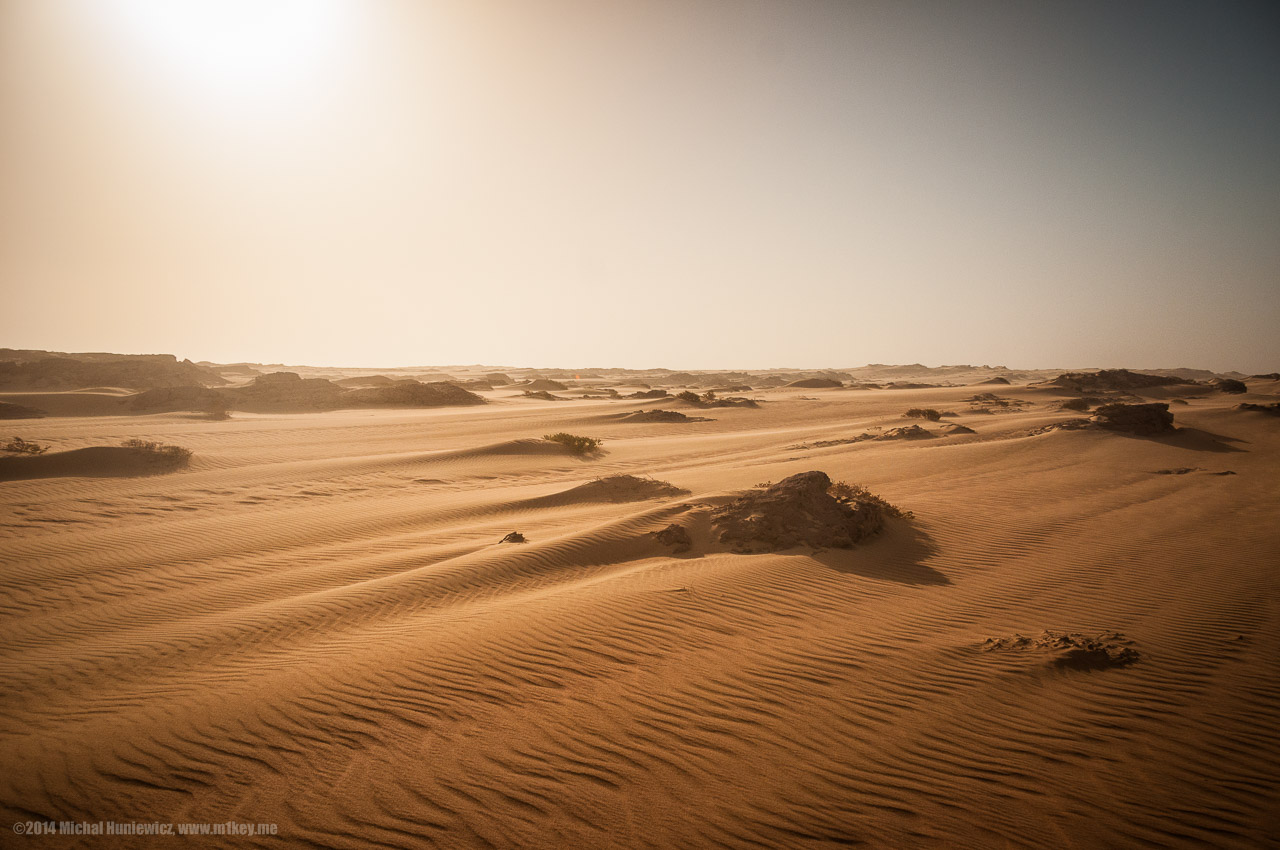
Dunes, resembling the waves of a petrified sea, seem immobilised by geological rigor mortis, but these ones are a deadly trap. Not far from here are land mines awaiting those
who attempt to cross into the Western Sahara, the unrecognised internationally territory that refuses to be part of Mauritania or Morocco. The Sahara is, indeed, a bit of a graveyard, with
camel skeleton-strewn trails, empty carcasses of vehicles reminding us that travelling across the desert isn't as easy as it may seem, and of dead birds, who travel here every winter from
Europe. [6]
ISO 200, 18mm, f/5.6, 1/2000s.
Dirty Sensor
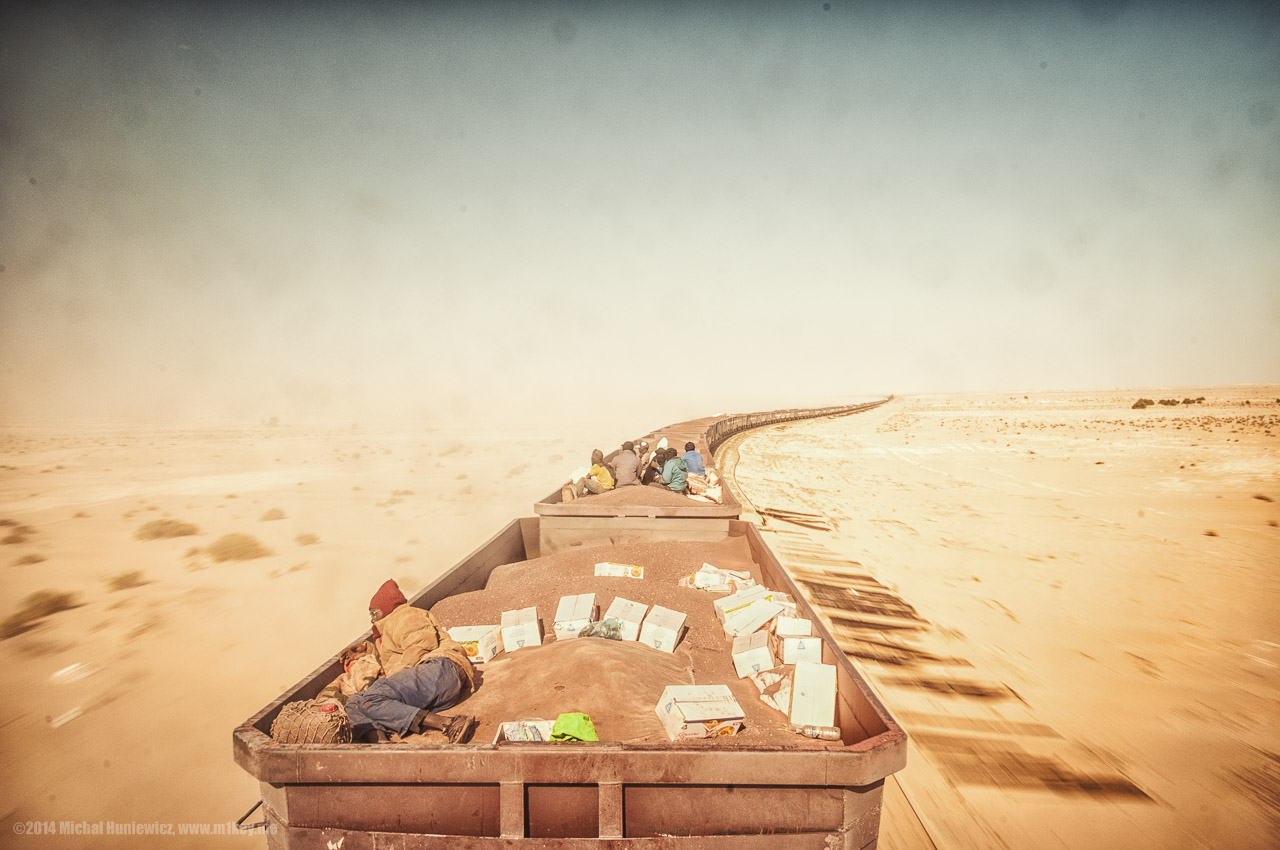
The Saharan and iron dust in the air did this to my camera and lens. Notice the spots everywhere. While I didn't change lenses on the train, the zoom lens I used extends,
and that sucks in all the particles in the air. Unfortunately, it damaged the lens to the point where it is no longer usable.
I recommend, for such activities, lenses that don't expand, with at least a UV filter; and all your equipment, even if unused, should be securely sealed. My dad said condoms would do just fine for wrapping electronic equipment (seriously).
I recommend, for such activities, lenses that don't expand, with at least a UV filter; and all your equipment, even if unused, should be securely sealed. My dad said condoms would do just fine for wrapping electronic equipment (seriously).
ISO 200, 18mm, f/22, 1/20s.
Dirt
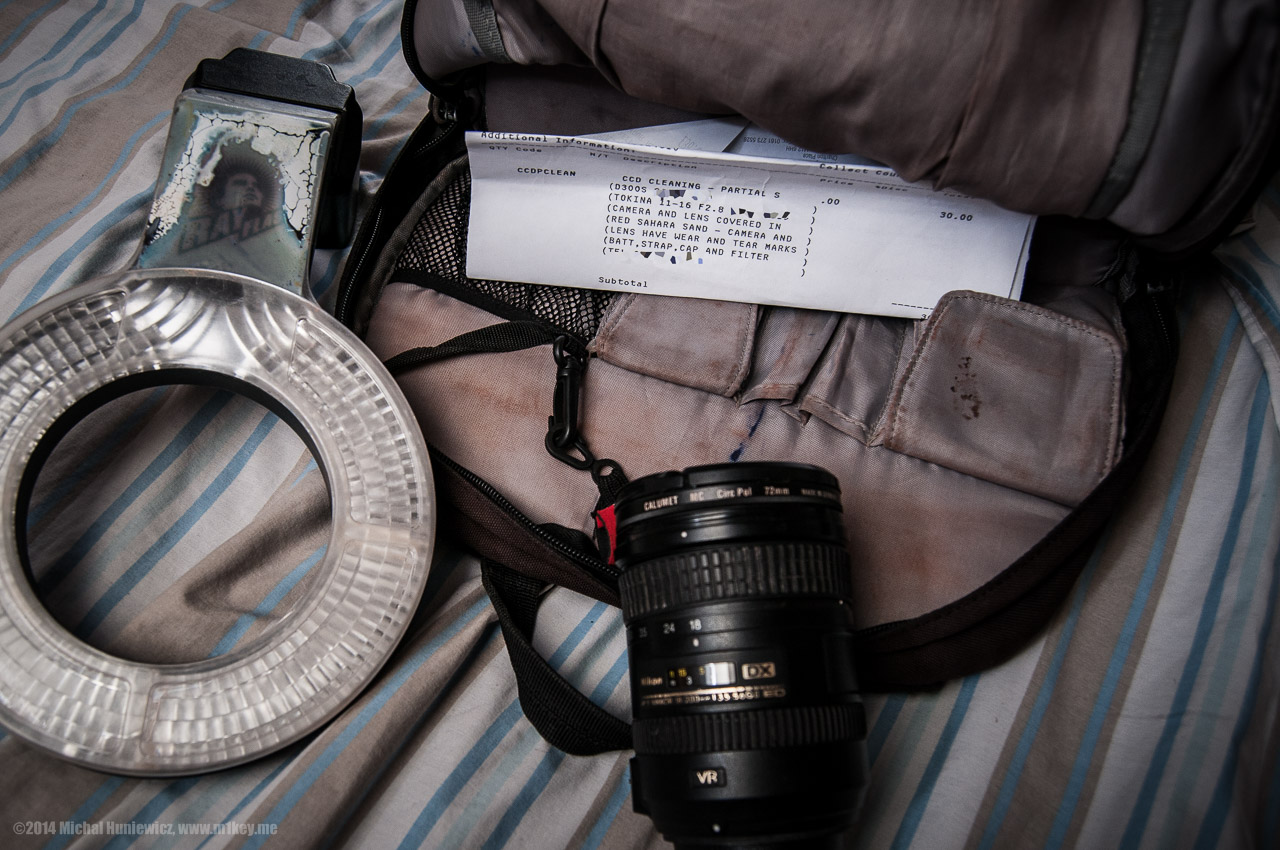
[Taken after the trip.] I had to have the sensor cleaned, but it doesn't really pay off to have the lens repaired. Goodbye, old friend!
The bag is stained with iron. I was told iron can be used for dyeing... The trip also ruined my ring flash, and my mp3 player was damaged and beyond repair, too.
The clothes I used on the train all went to the bin, including my old travelling trousers I was too skinny to wear.
The bag is stained with iron. I was told iron can be used for dyeing... The trip also ruined my ring flash, and my mp3 player was damaged and beyond repair, too.
The clothes I used on the train all went to the bin, including my old travelling trousers I was too skinny to wear.
ISO 200, 18mm, f/22, 1/20s.
Final Destination
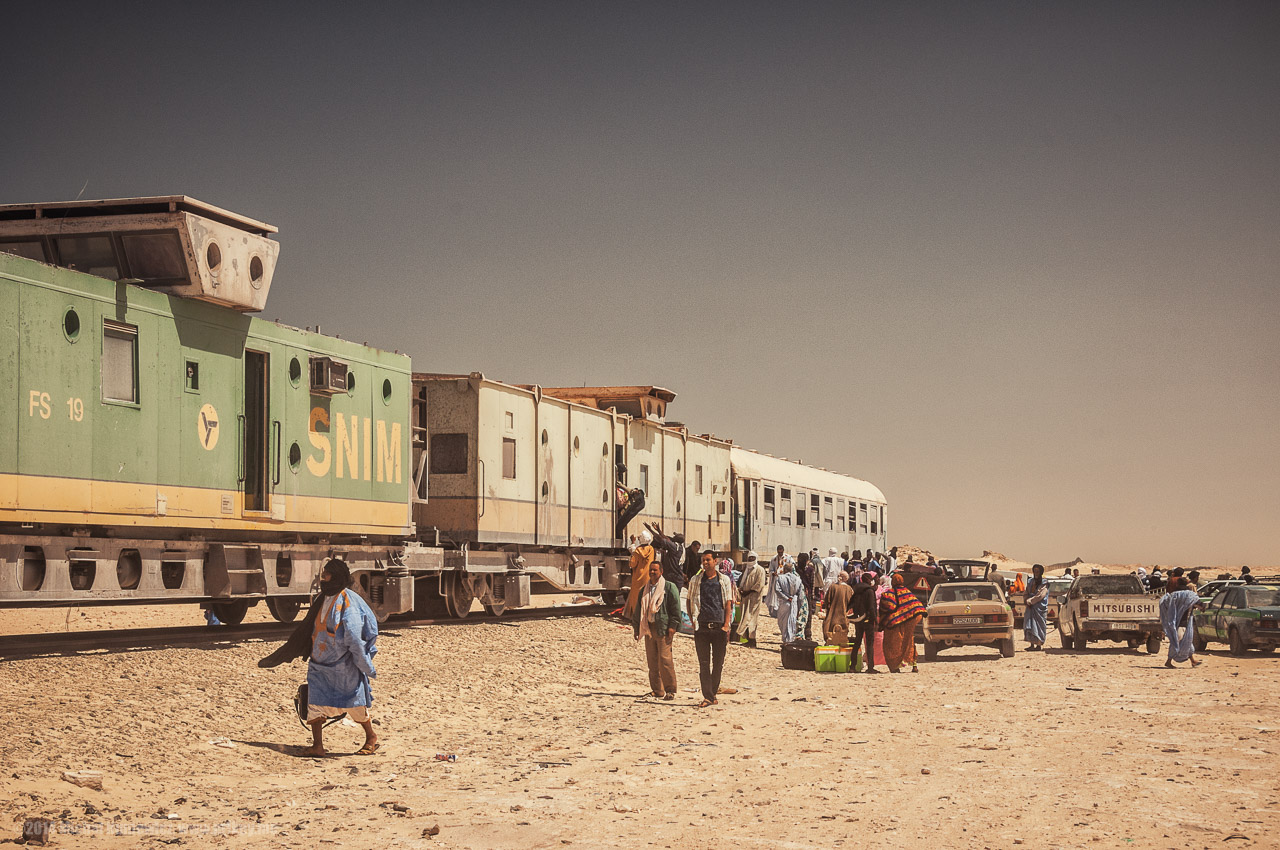
Finally, after roughly 14 hours, we arrived in Nouadhibou. Unlike the romantic end of journey of the Lunatic Express on the other side of Africa,
the Mauritanian train stopped pretty much in the middle of nowhere, with not much but packs of taxi drivers awaiting the passengers.
ISO 200, 36mm, f/14, 1/125s.
Woops

Boxes of pasta that travelled with us on the iron ore were quickly offloaded. With them, some goats arrived as well, and other boxes we didn't bother to identify.
I expected the train to be more lively based on what I had read online, but perhaps that only happens during the day.
I didn't realise how dirty my face was when I finally got off the train - funnily enough, everyone was very discreet and polite about it, so it only occurred to me in the hotel bathroom that I looked a guy who just got rejected in the new KISS band member recruitment process - with weird black shapes all over my face.
I didn't realise how dirty my face was when I finally got off the train - funnily enough, everyone was very discreet and polite about it, so it only occurred to me in the hotel bathroom that I looked a guy who just got rejected in the new KISS band member recruitment process - with weird black shapes all over my face.
ISO 200, 34mm, f/14, 1/125s.
Passengers
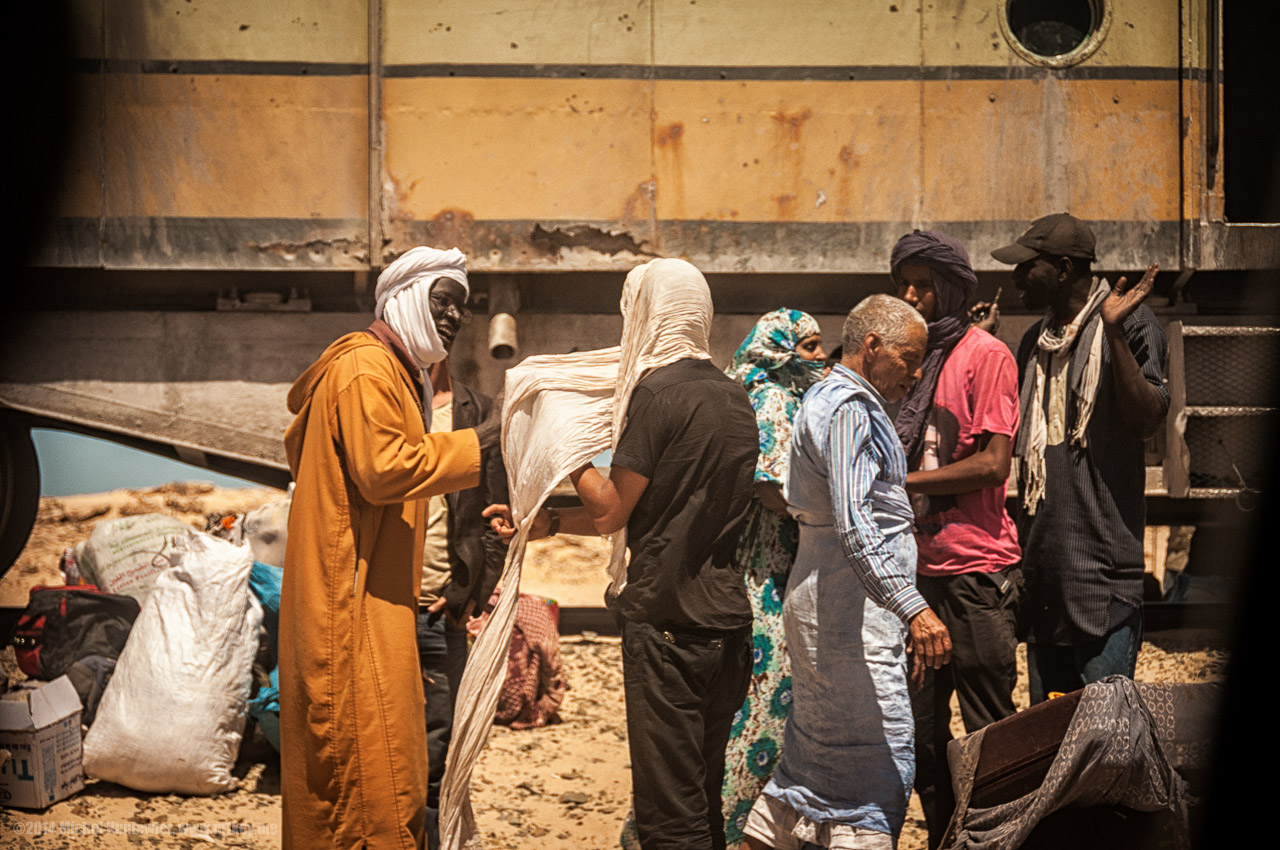
There was the usual hustle and bustle, but we tried to leave as soon as possible - just to have our passports confiscated by the police. It cost us 1000 ouguiya each to get them back,
and we were helped by a man of a peculiar appearance whose watch, I noticed, had no hands.
ISO 200, 70mm, f/5.0, 1/1000s.
Locomotive
Towards the Atlantic Coast

After a short break and shower in the hotel (I ruined the bathroom and towels - iron dust everywhere!), we headed to Cap Blanc - a peninsula near Nouadhibou, now known also as Ras Nouadhibou, by the Tropic of Cancer.
We were lucky enough to get a taxi driver who knew the place well; he said he used to go fishing there, and showed us around. We think that the fact that Ammar is originally from Baghdad made people more helpful and friendly - Mauritania and Iraq used to be allies, and there used to be portraits of Saddam Hussein everywhere. [2]
We were lucky enough to get a taxi driver who knew the place well; he said he used to go fishing there, and showed us around. We think that the fact that Ammar is originally from Baghdad made people more helpful and friendly - Mauritania and Iraq used to be allies, and there used to be portraits of Saddam Hussein everywhere. [2]
ISO 200, 18mm, f/6.3, 1/400s.
Terrible Dog Attack!
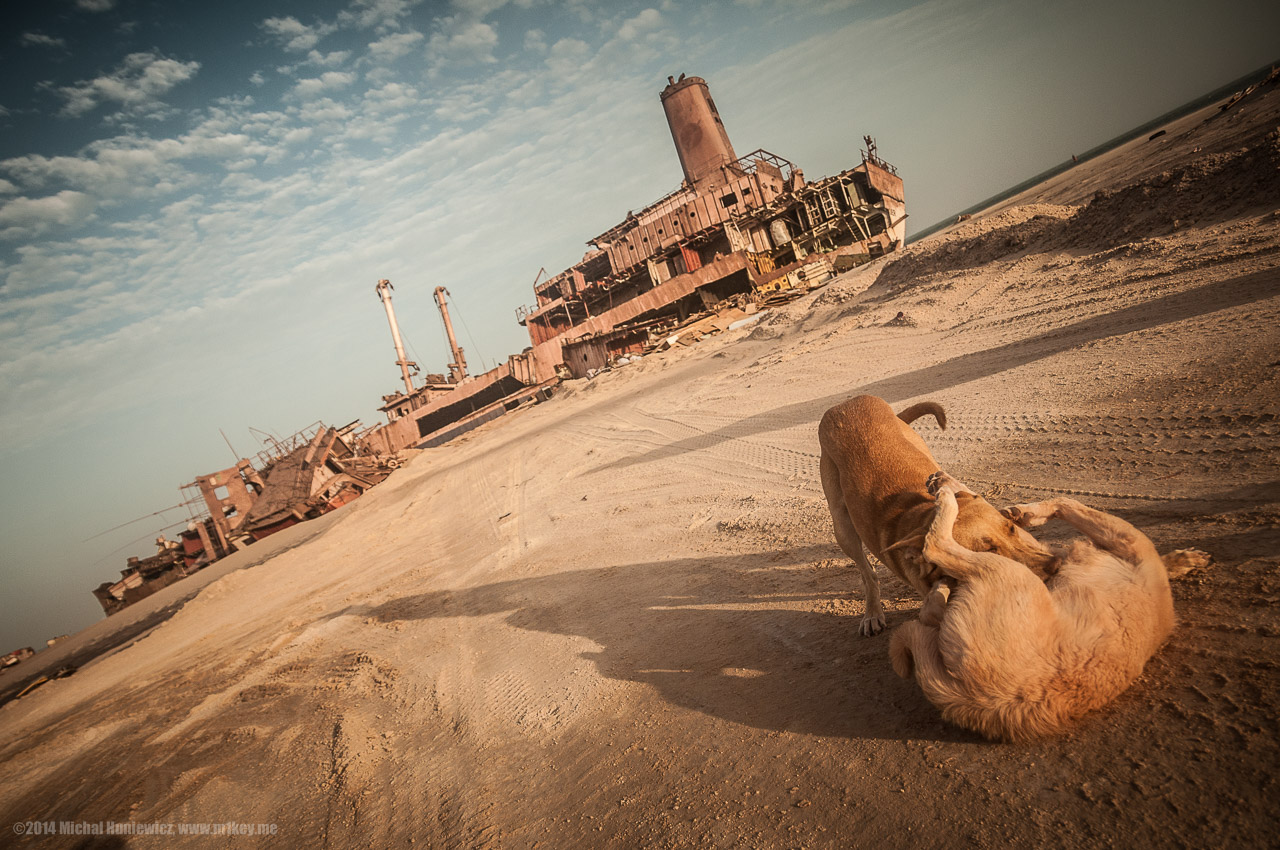
This is what remains of the wreck of the United Malika. It used to be more complete, but now it's being taken apart, and you are not allowed to get close.
The ship ran aground in 2003. [8] This place used to be a ship graveyard, but there is now an ongoing EU initiative to remove the wrecks.
To even see it we had to hand over a small sum of money to a local guard. "Your bribe will be used for the restoration of the museum."
To even see it we had to hand over a small sum of money to a local guard. "Your bribe will be used for the restoration of the museum."
ISO 200, 18mm, f/4.5, 1/500s.
Modest Museum
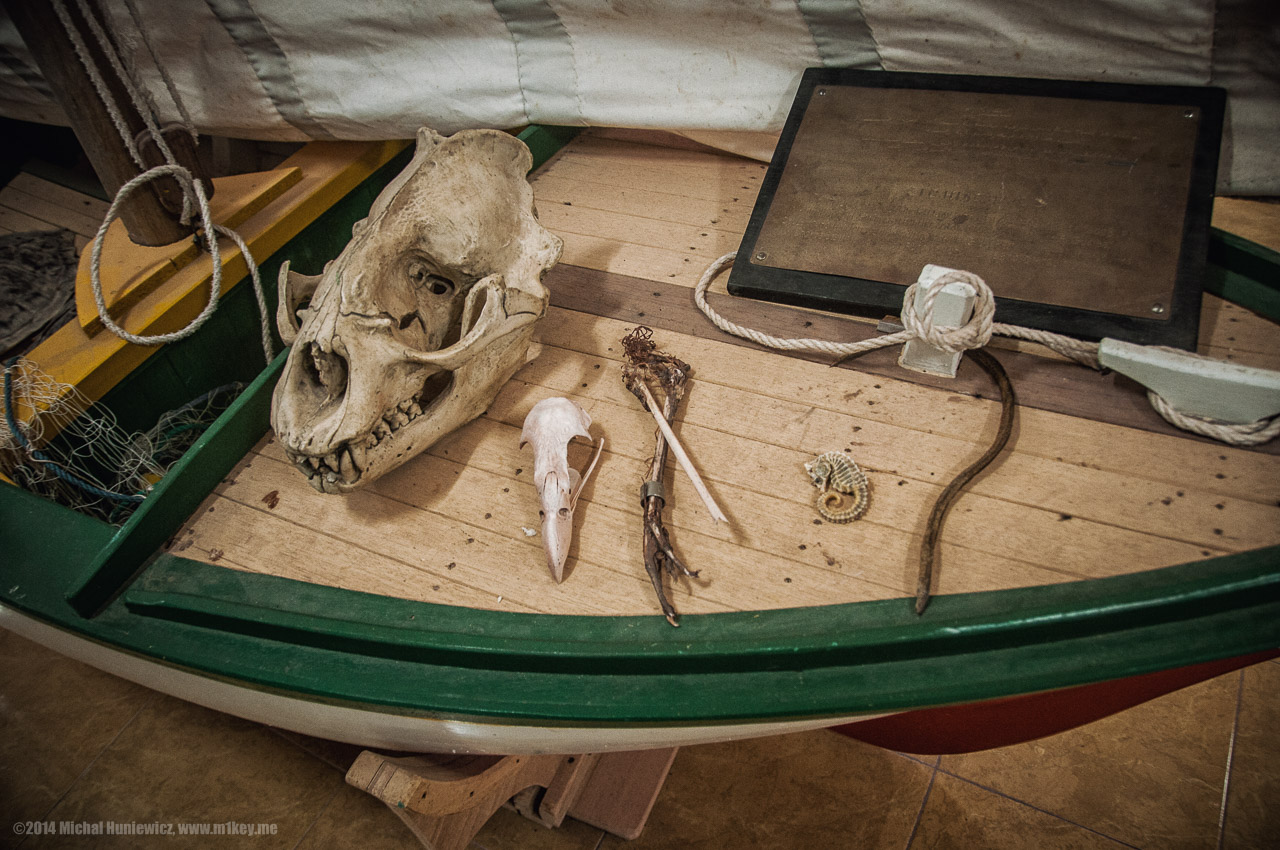
Might as well see the museum. Well, there wasn't a great deal to see there, but we were guilted into buying a book on seals - to support the seals.
There is an ongoing effort to restore the local monk seal colony [9], so perhaps Mauritania is slowly becoming more environment-aware.
ISO 360, 18mm, f/3.5, 1/15s.
No Smoke Without Fire
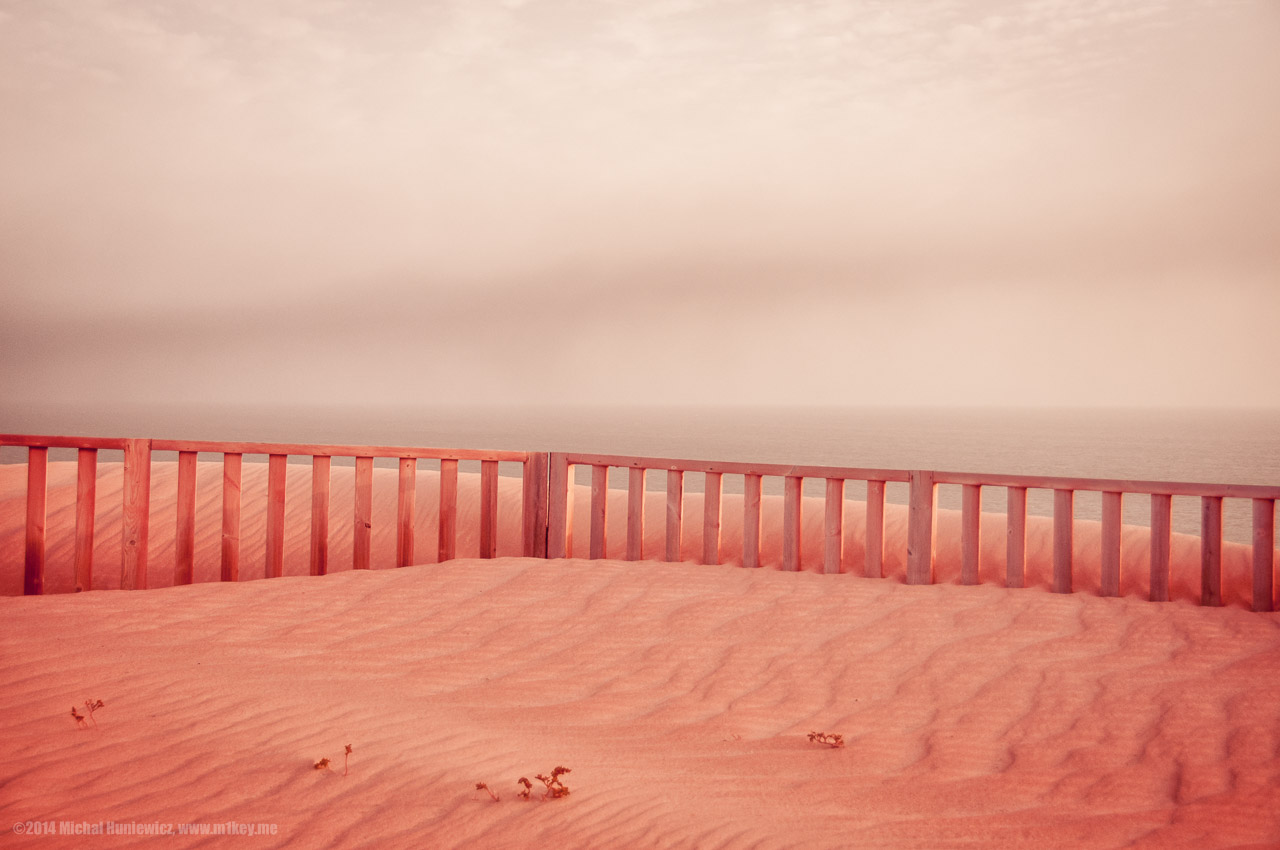
Mauritania is quite polluted, nevertheless - there was this constant, menacing flow of dark smoke coming from Nouadhibou.
ISO 200, 36mm, f/4.2, 1/250s.
Camel Man
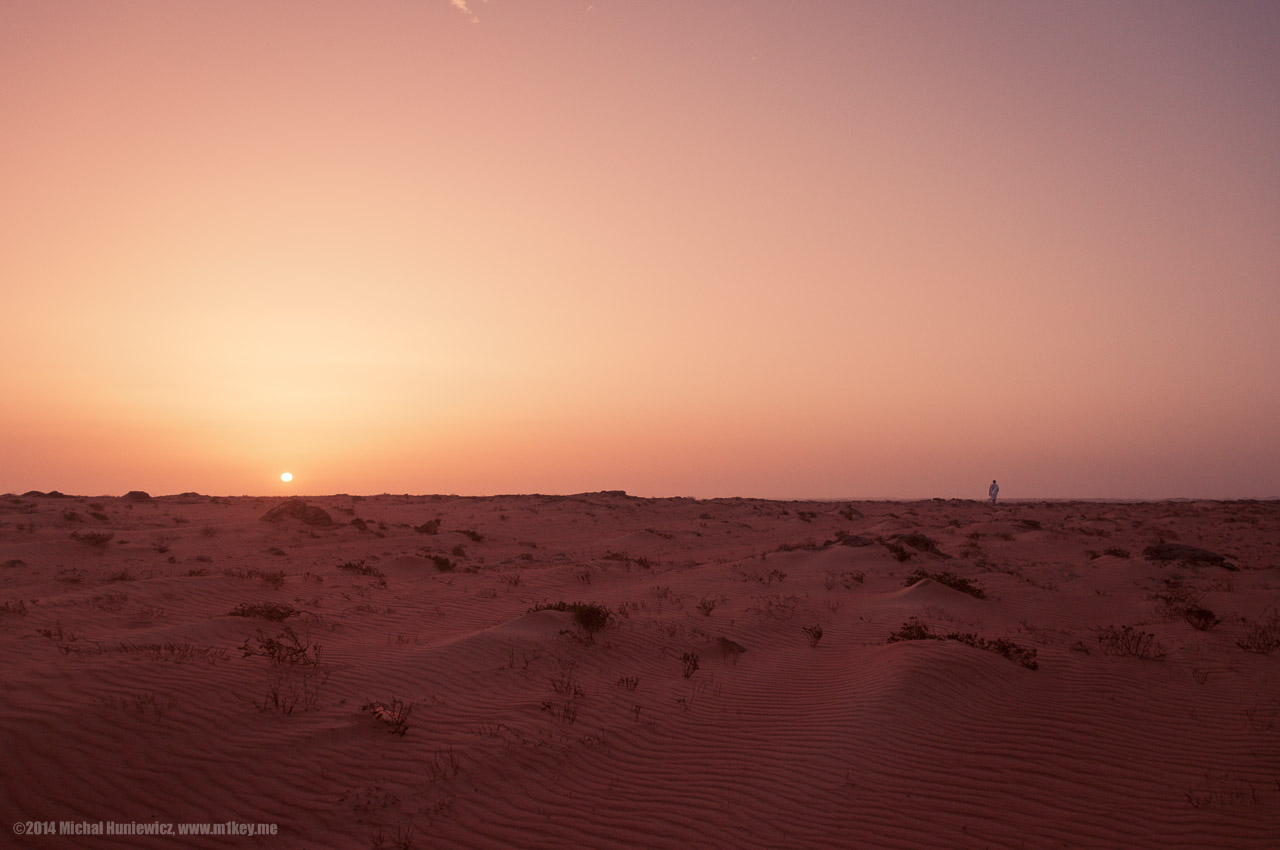
On our way back from Cap Blanc, our guide left us behind easily. I called him "camel man".
ISO 200, 18mm, f/3.5, 1/1000s.
Morning in Nouadhibou
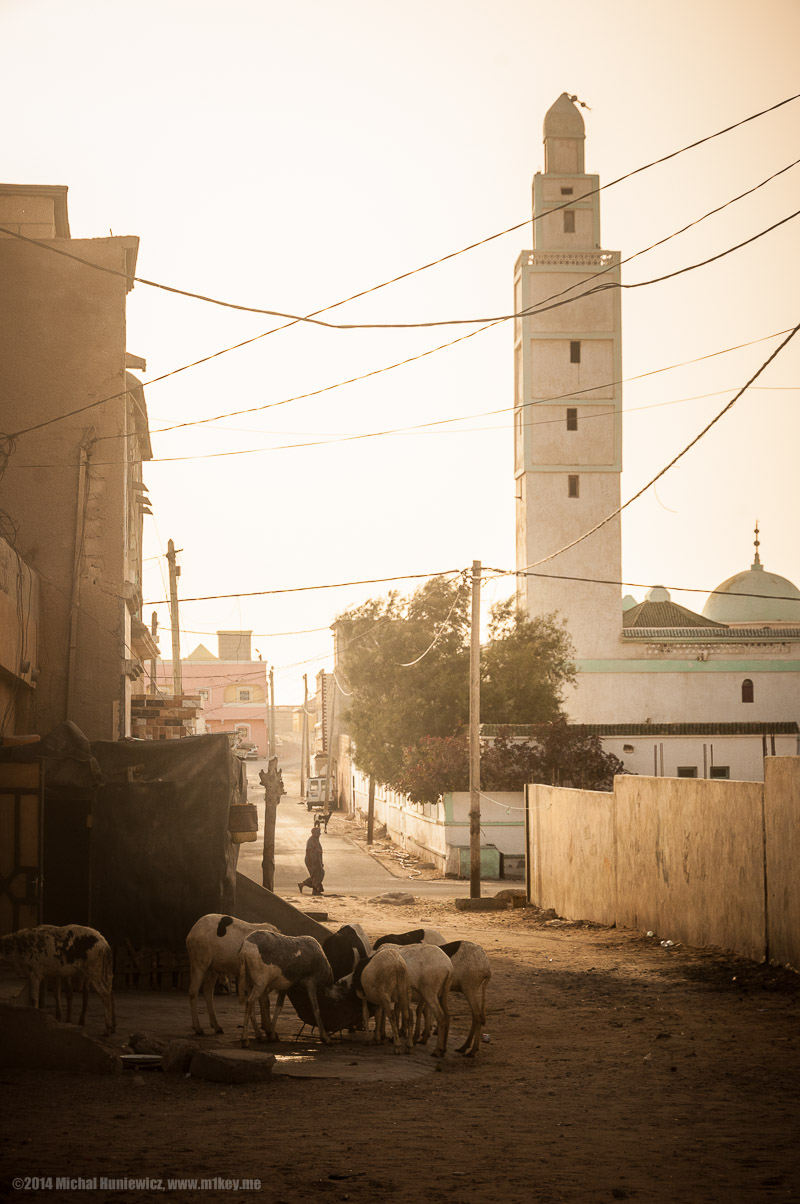
Harsh light in Africa doesn't make photography easy, but it was very welcome after the grey London bore. In the past, European painters would
come to the Sahara to experience this light, and would be forever changed by the experience. [7]
Best light for photography is when shadows are long - in the middle of the day you may want to try infrared photography instead, but I didn't try.
Best light for photography is when shadows are long - in the middle of the day you may want to try infrared photography instead, but I didn't try.
ISO 200, 56mm, f/11, 1/160s.
Maata Moulana

There was only one night in Mauritania before the flight, but I still hadn't photographed a madhara... We had only one chance left, so we went to Maata Moulana, a town
we had never heard about. It stands in the middle of the Sahara, and no roads lead to it - we spent quite a bit of time getting there, as our driver initially lost his way.
This is where they teach the "true Islam", say the residents. Maata Moulana means "God's gift". [10]
This is where they teach the "true Islam", say the residents. Maata Moulana means "God's gift". [10]
ISO 200, 50mm, f/1.4, 1/160s.
Local Currency
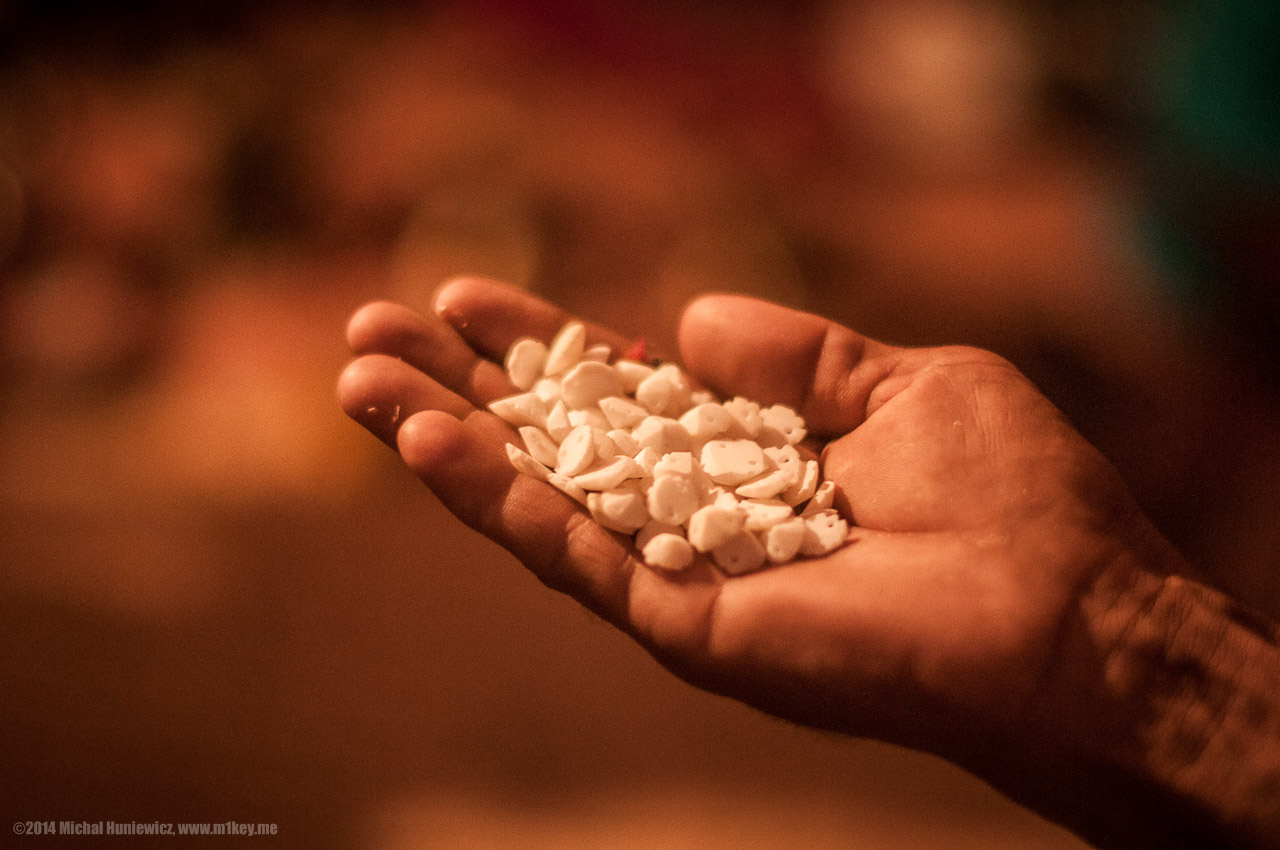
Following a branch of Sufism, Maata Moulana is aimed to be a Muslim utopia, the perfect Muslim society. No alcohol or tobacco is allowed, there are no TVs at home,
and it is up to local leaders to resolve conflicts between the inhabitants. They haven't banned smart phones yet, and after the dinner many heads would bathe in the sharp glow
of their samsungs and nokias and iPhones.
Unlike virtually any city or town I have seen in the Middle East or Africa (with the exception of Monastir, Tel Aviv, and some parts of Jerusalem), this one is fairly clean.
In the photo, what is used, alongside money, as currency in the town - these are fish teeth. [10]
Unlike virtually any city or town I have seen in the Middle East or Africa (with the exception of Monastir, Tel Aviv, and some parts of Jerusalem), this one is fairly clean.
In the photo, what is used, alongside money, as currency in the town - these are fish teeth. [10]
ISO 800, 50mm, f/1.4, 1/30s.
Money
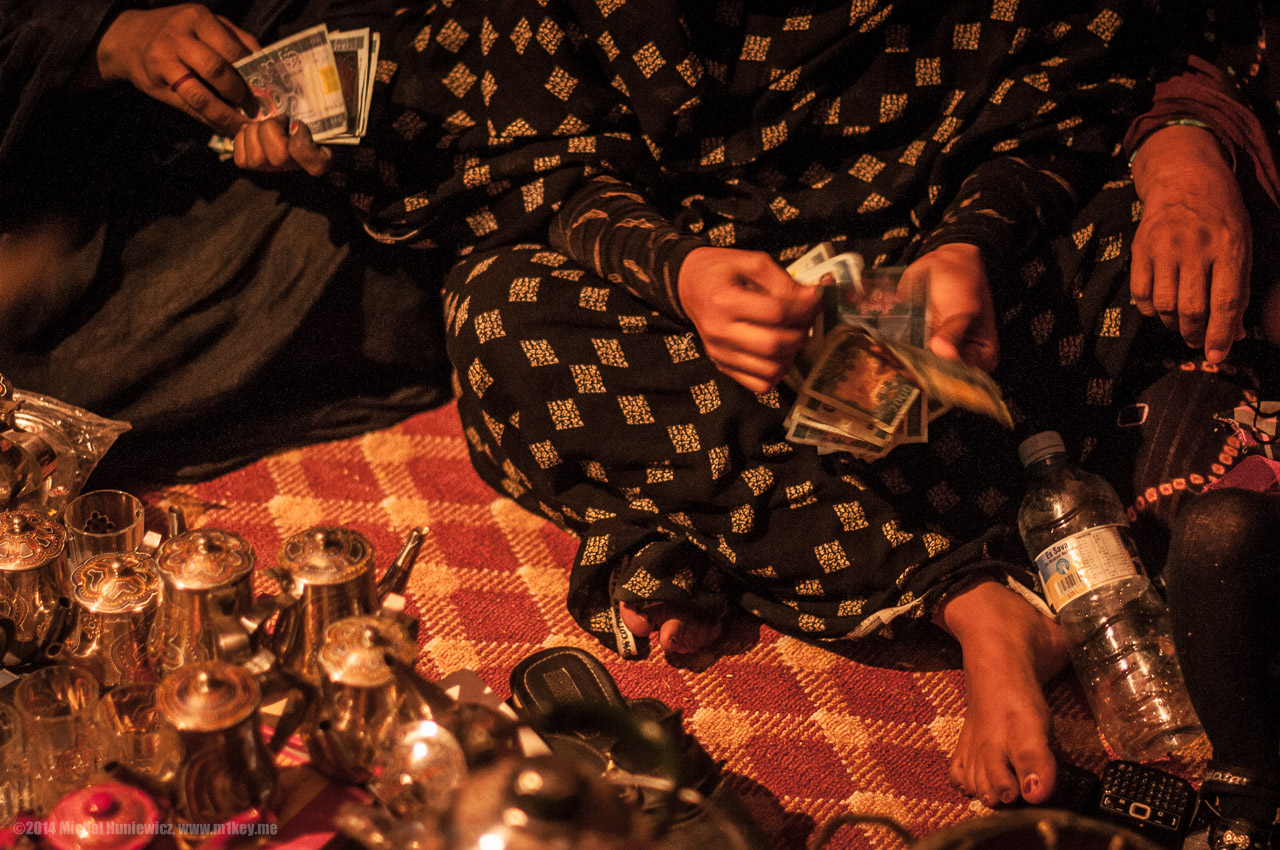
Religious perfection and idealism aside, there is a place where they will sell you souvenirs. Most women covered their faces as soon as I lifted my camera. Either way, it was too late to photograph a madhara,
so I made a controversial decision - we were staying for the night. Ammar is a patient man.
ISO 800, 50mm, f/1.4, 1/30s.
Boy with Big Eyes
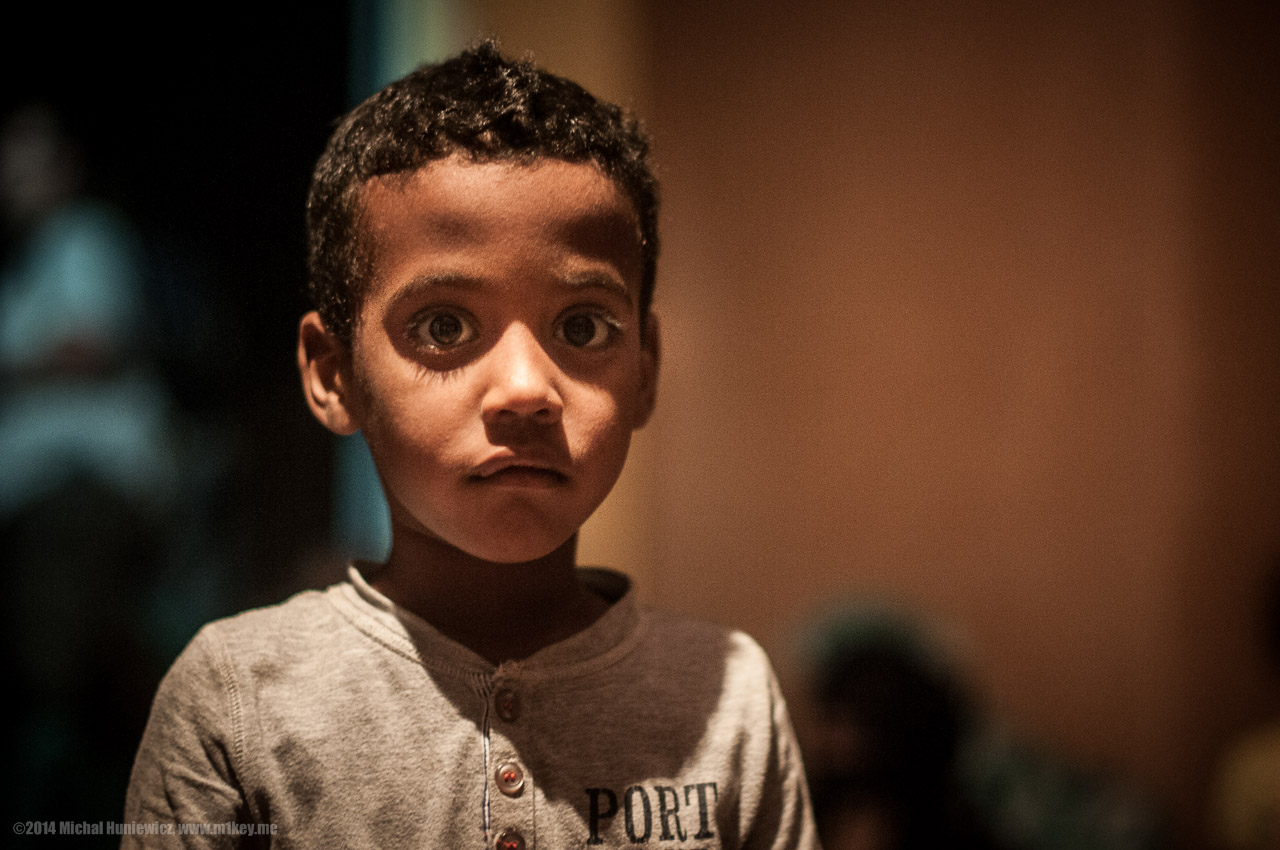
The town is fairly independent of Mauritanian administration, and its inhabitants are granted quite a lot of independence. There are many students of Islam, some from abroad.
We met people from South Korea, Spain (from Andalusia), or various African countries. Education costs less than one euro per week, and the students stay with the locals. [10]
The town resembles to some extent a monastery, with its modest rooms and houses.
ISO 800, 50mm, f/1.4, 1/30s.
Madhara
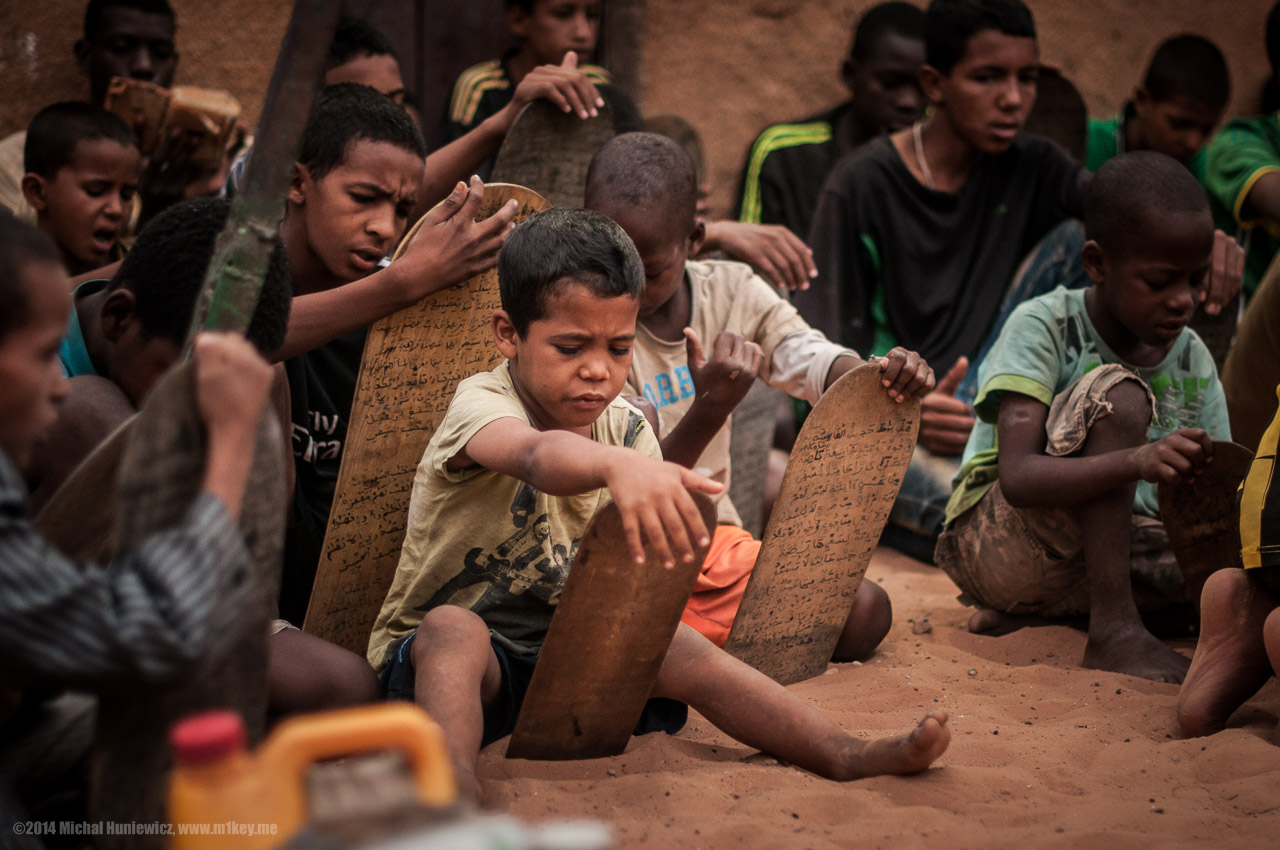
After dining with the sheikh, we were offered a modest room in his house for the night, but preferred to sleep under the starry skies of the Sahara. Around 4AM I dreamt that I couldn't switch off my music player,
to be woken up by rather terrifying and aggressive screams of "Allahu Akbar!", coming from a nearby mosque.
In the morning though - madhara, at last...
In the morning though - madhara, at last...
ISO 250, 50mm, f/1.4, 1/50s.
Learning the Quran by Heart

After a week of being out of luck, finally I got to photograph a madhara. A madhara is a Quranic school where people (not necessarily children) memorise the Quran.
This is a very old tradition indeed - the Quran was only fully transcribed and collated after the Prophet Muhammad's death, and before that it was repeated aloud among believers from memory. [11, p. 66-67]
This is a very old tradition indeed - the Quran was only fully transcribed and collated after the Prophet Muhammad's death, and before that it was repeated aloud among believers from memory. [11, p. 66-67]
ISO 400, 50mm, f/1.4, 1/40s.
Lewandowski in Mauritania
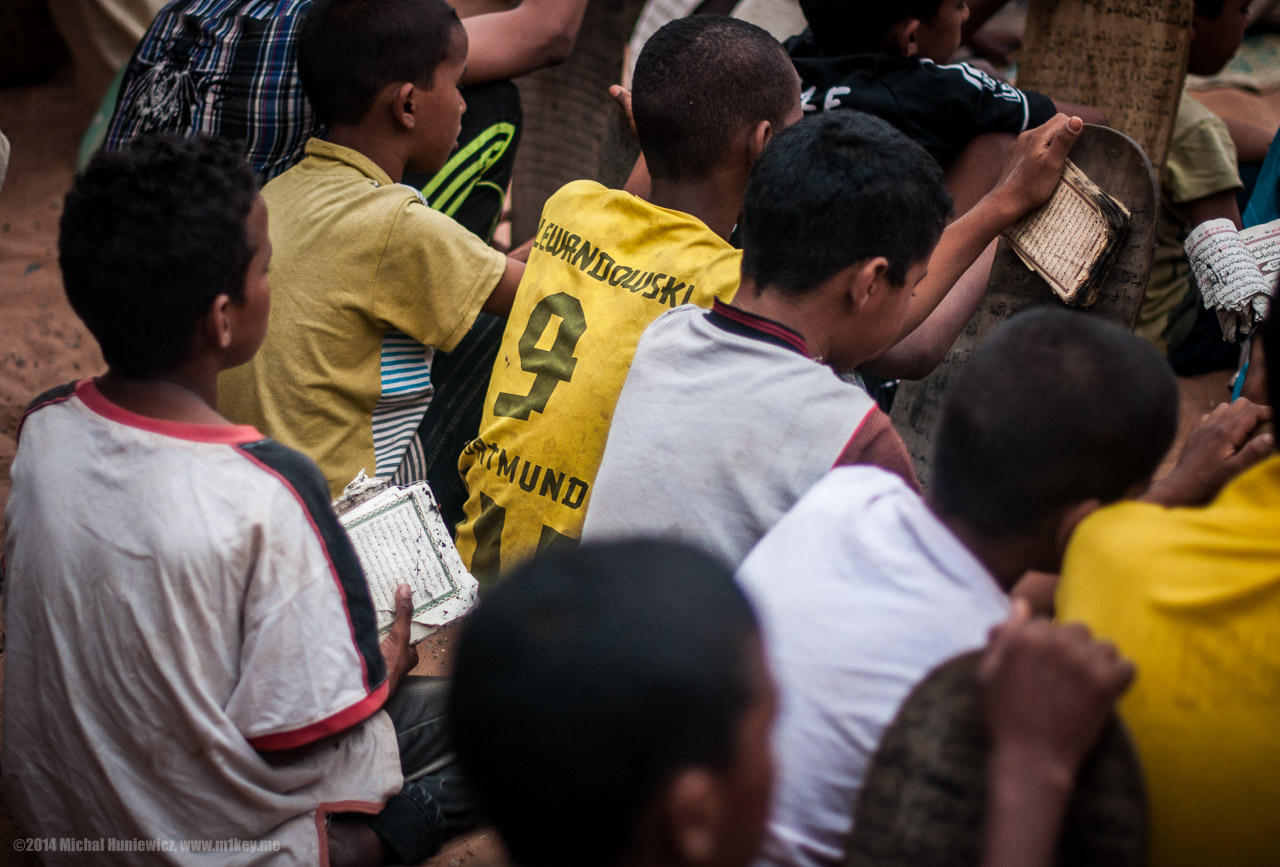
As the kids begin to learn the Quran, they were quickly interrupted. "Er, can you move 'em there? I need more light!" - we started shooting really early. Then, among the boys (girls have separate madharas),
I saw this - a t-shirt of the Polish football player, Lewandowski!
ISO 200, 50mm, f/1.4, 1/125s.
And Another One!
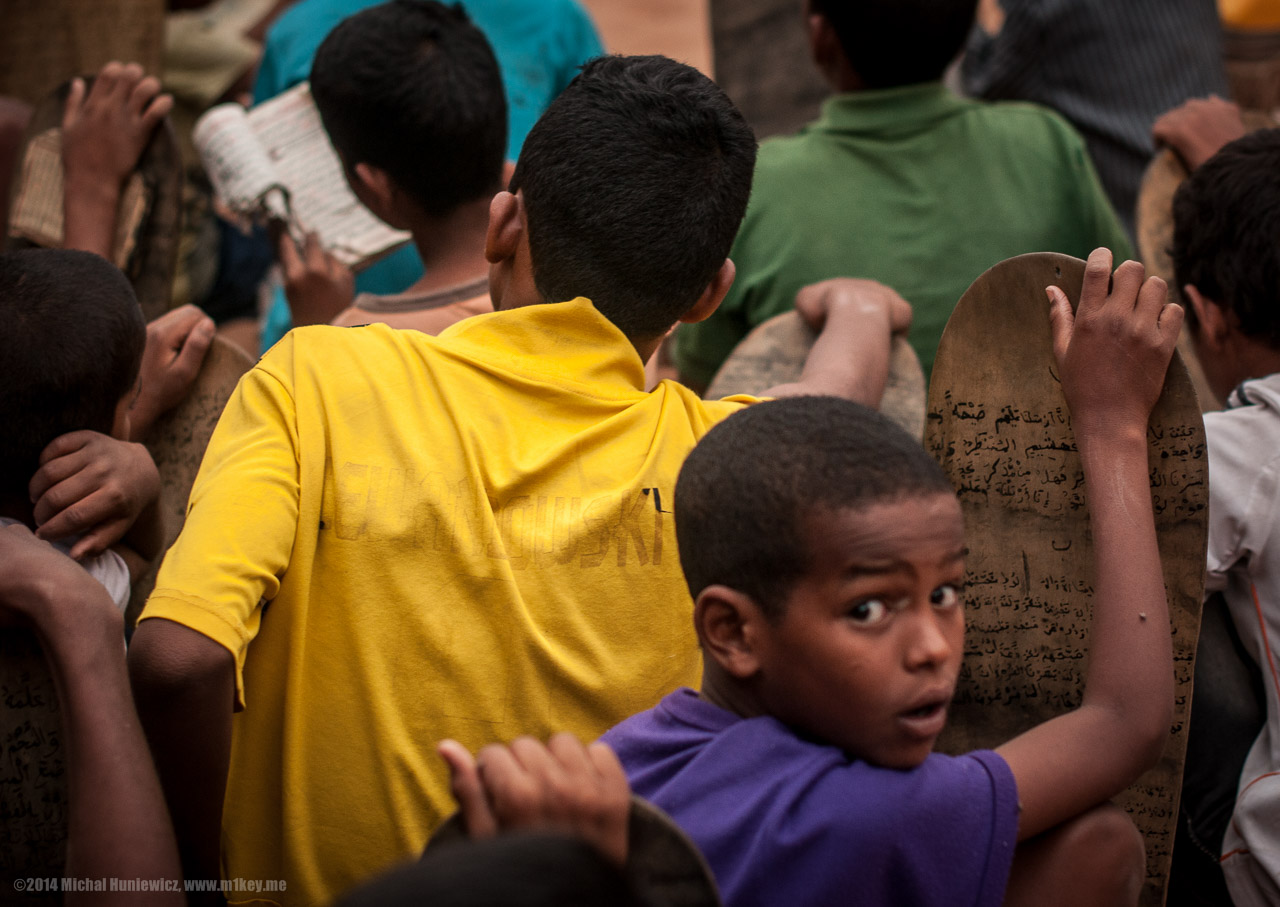
There was another one. Lewandowski in the middle of the Sahara.
ISO 200, 50mm, f/2.2, 1/80s.
Boys in a Madhara
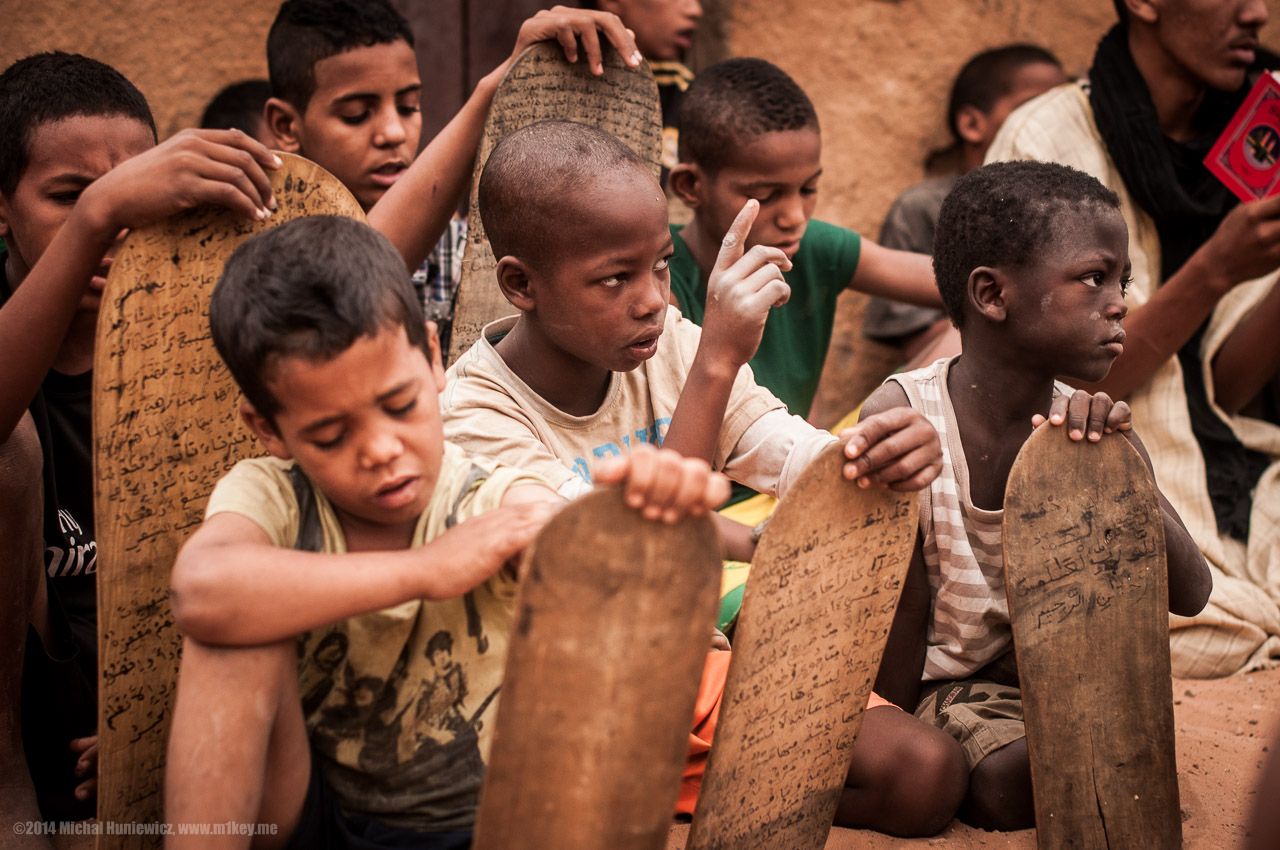
Kids spend their days sharing time between Quranic and modern teaching. Men's religious teaching ends when they have learnt all of the Quran by heart. Women must
only memorise a twelfth.
ISO 200, 50mm, f/2.5, 1/50s.
Wooden Tablet
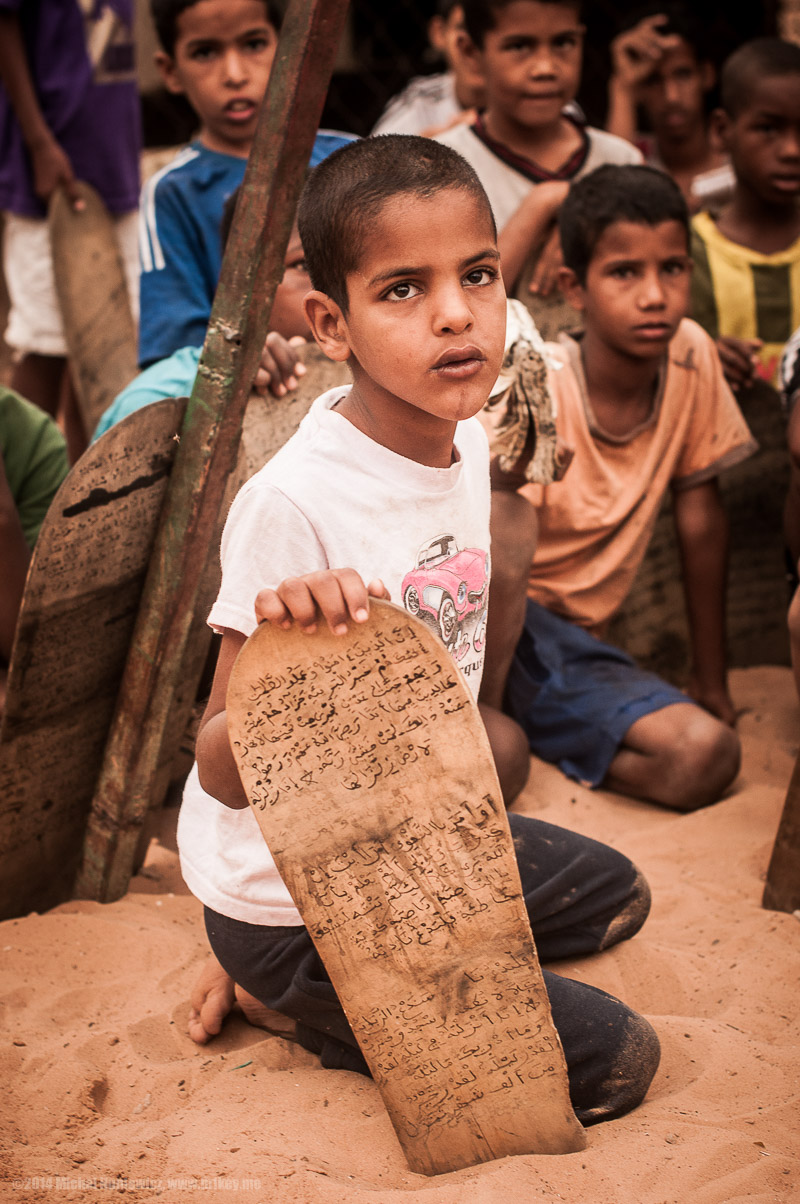
Learning ancient texts by heart - sounds like the education I received in Poland!
ISO 200, 50mm, f/3.2, 1/125s.
Boy in Maata Moulana
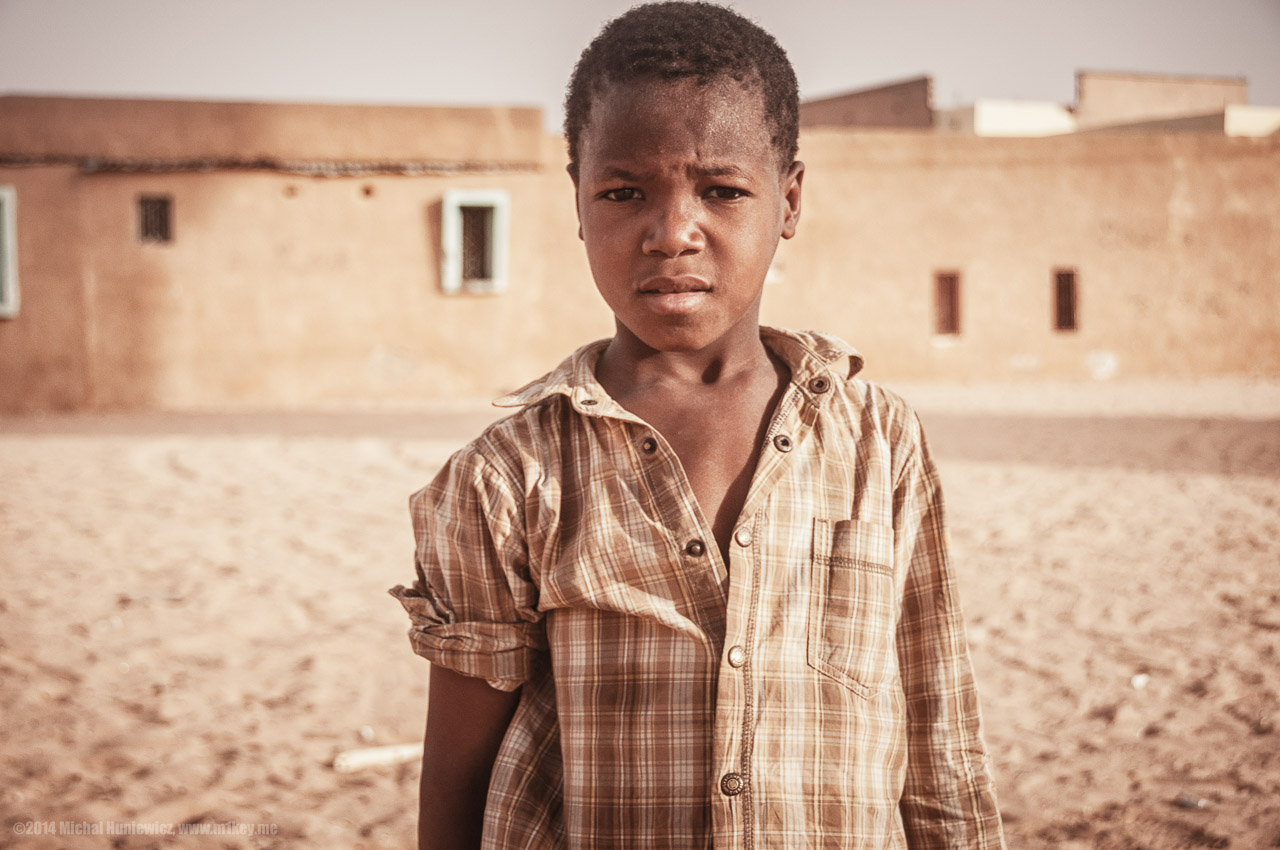
No other country has a higher number of slaves per 1000 people than Mauritania today,
and while the presence of French colonialists helped to limit the extent of slavery, it did not eliminate it completely, despite several legal attempts to abolish it. The slaves are exclusively black, and the masters are the lighter skinned Berbers or Berber-Arabs,
who have always considered themselves to be the white race. [6, p. 71] According to some estimations, as many as 20% of people in Mauritania are slaves, despite
an ongoing effort to eradicate it. [12]
Now that slavery is illegal, there are no slave markets as such. The black people in Mauritania, however, even when free, are said to face discrimination. [13] Only one person has been persecuted for owning slaves so far, and she was sentenced to six months in jail. [14] Just as religious law is difficult to impose in remote populations in the desert, it isn't easy to impose an anti-slavery ban.
(There is no reason to believe the boy in the photo is a slave.)
Now that slavery is illegal, there are no slave markets as such. The black people in Mauritania, however, even when free, are said to face discrimination. [13] Only one person has been persecuted for owning slaves so far, and she was sentenced to six months in jail. [14] Just as religious law is difficult to impose in remote populations in the desert, it isn't easy to impose an anti-slavery ban.
(There is no reason to believe the boy in the photo is a slave.)
ISO 200, 35mm, f/4.5, 1/1250s.
Mosque in Maata Moulana
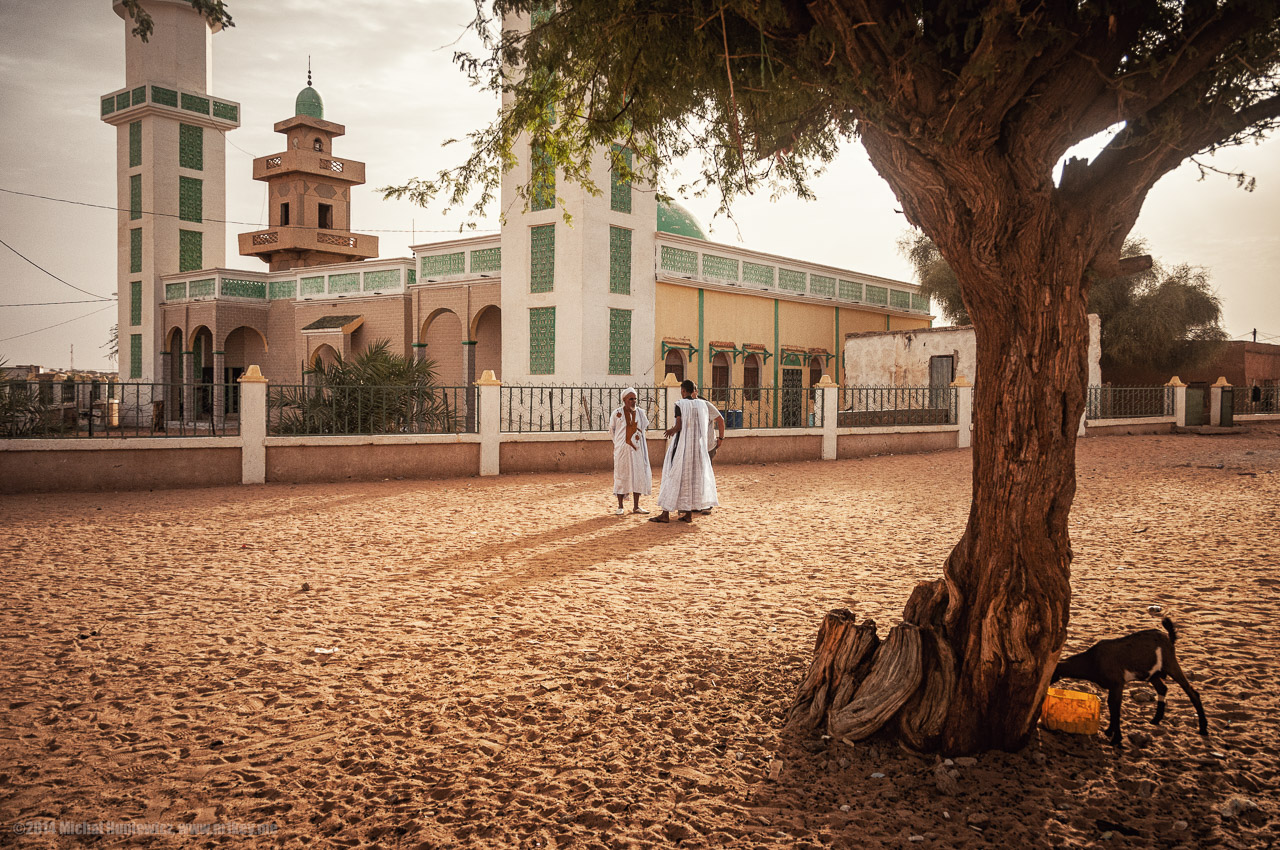
Maata Moulana was founded only in the late 1950s, founded by a man from Senegal, where there was an unmarked grave of a Belgian convert to Islam.
Today, it is run by the man on the left, the sheikh, referred to as el Hadj. [10]
ISO 200, 18mm, f/4.5, 1/2500s.
Sheikh
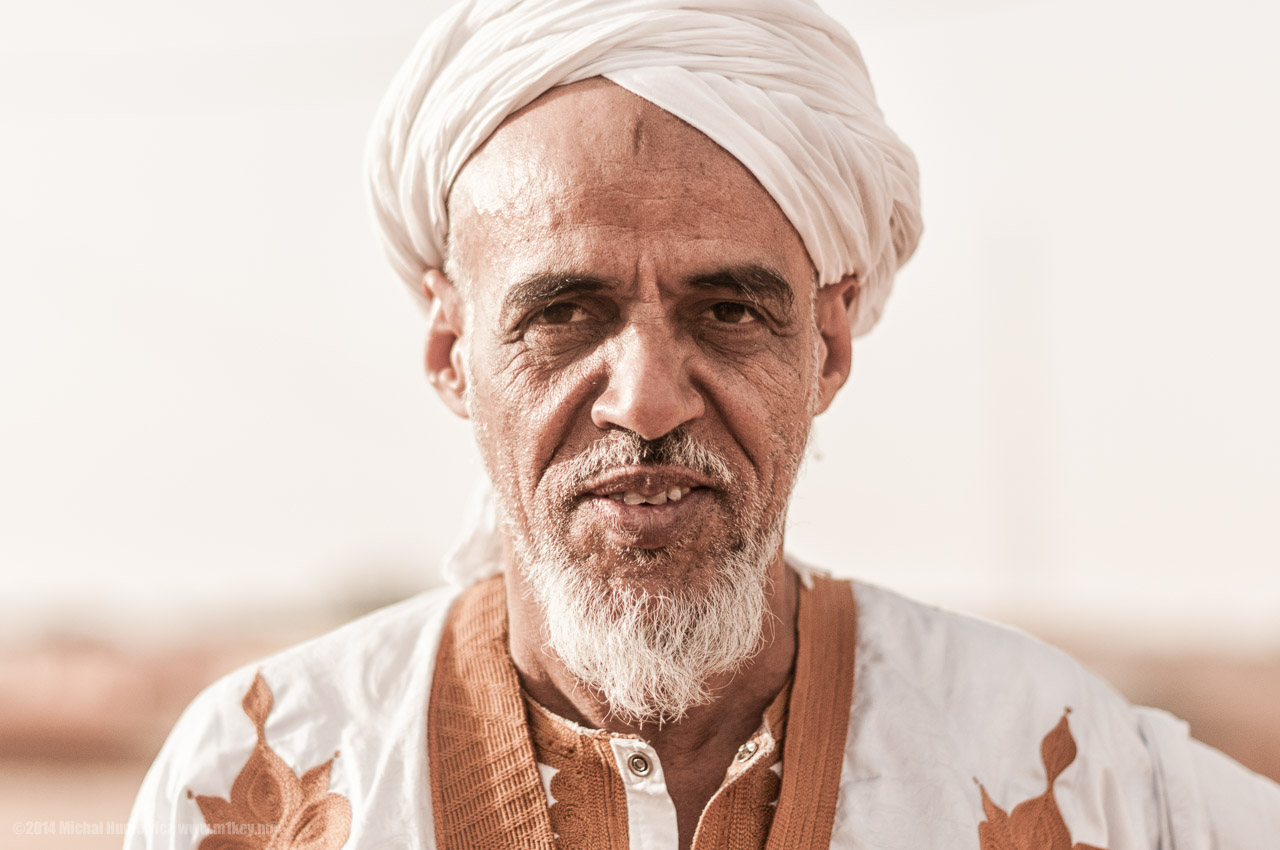
This is Ould Abdallah el Hajj Mishry, the man who was very hospitable to us, welcomed us in Maata Moulana, fed us, and even gave us gifts when we were leaving for Nouakchott!
The man also has three wives. [10]
He told us about Islam, but in a manner I didn't find unpleasant; without the usual preaching and patronising (which cannot be said about some of his disciples). Aware of the troublesome aspects of the Quran in today's day and age, he described the holy book of Islam as a pharmacy - you take what you want depending on what you need, but not everything and not in excessive amounts.
Except for the howling of the muezzin, I found the atmosphere of Maata Moulana interesting and not threatening at all. Sure, the people were a bit too serious about religion to my liking, but generally friendly and helpful, and mostly patient with my photographic expectations/demands.
On our way back, we picked up two people on their way to Nouakchott.
He told us about Islam, but in a manner I didn't find unpleasant; without the usual preaching and patronising (which cannot be said about some of his disciples). Aware of the troublesome aspects of the Quran in today's day and age, he described the holy book of Islam as a pharmacy - you take what you want depending on what you need, but not everything and not in excessive amounts.
Except for the howling of the muezzin, I found the atmosphere of Maata Moulana interesting and not threatening at all. Sure, the people were a bit too serious about religion to my liking, but generally friendly and helpful, and mostly patient with my photographic expectations/demands.
On our way back, we picked up two people on their way to Nouakchott.
ISO 200, 50mm, f/1.4, 1/8000s.
Grand Mosque - Mosque Marocaine
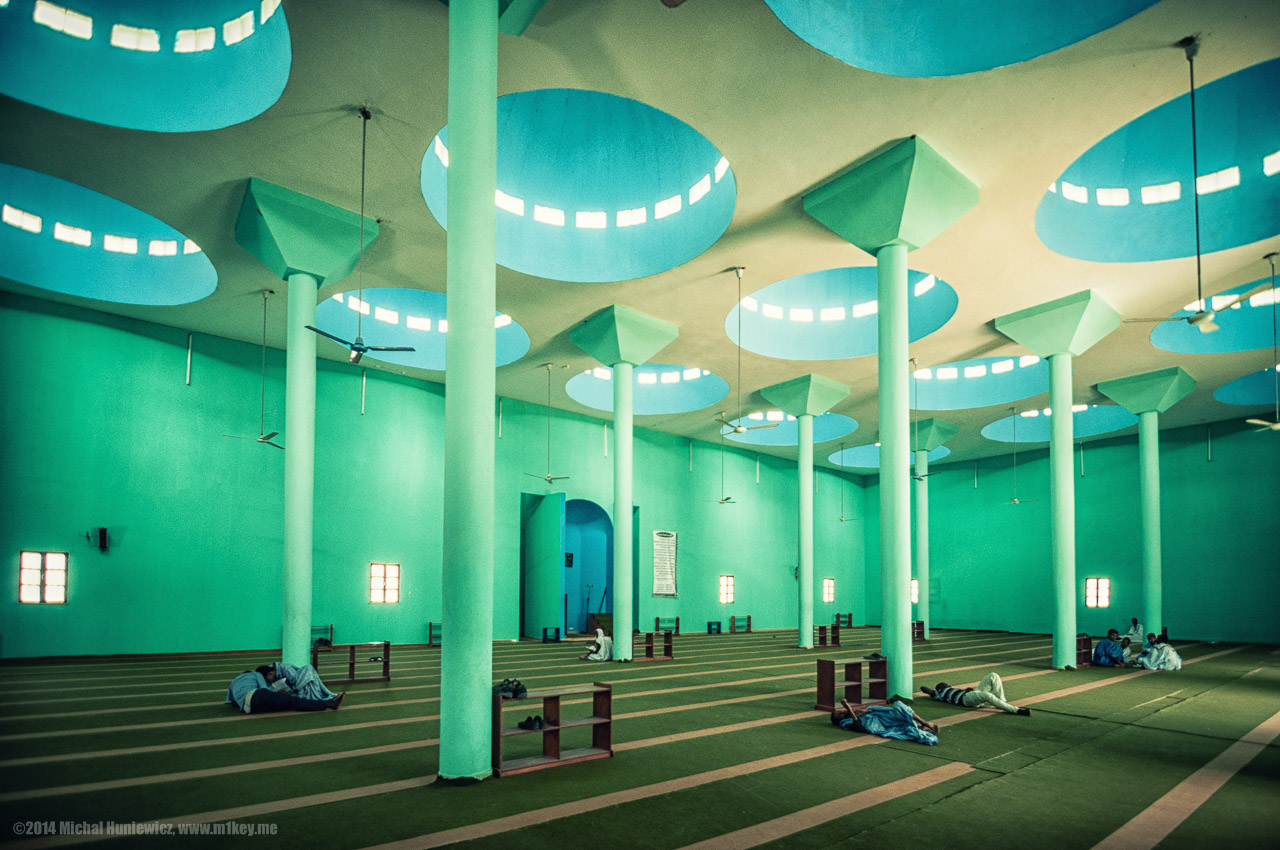
Back to Nouakchott!
I have heard people from the Western world that plenty of people in the Middle East or North Africa don't work, that they "just lie around doing nothing". It turns out that there exists a certain social hierarchy in those societies, and "conspicuous leisure" is the highest aspiration and mark of prestige. [6, p. 57]
I have heard people from the Western world that plenty of people in the Middle East or North Africa don't work, that they "just lie around doing nothing". It turns out that there exists a certain social hierarchy in those societies, and "conspicuous leisure" is the highest aspiration and mark of prestige. [6, p. 57]
ISO 200, 11mm, f/2.8, 1/160s.
Kids Holding onto a Moving Car
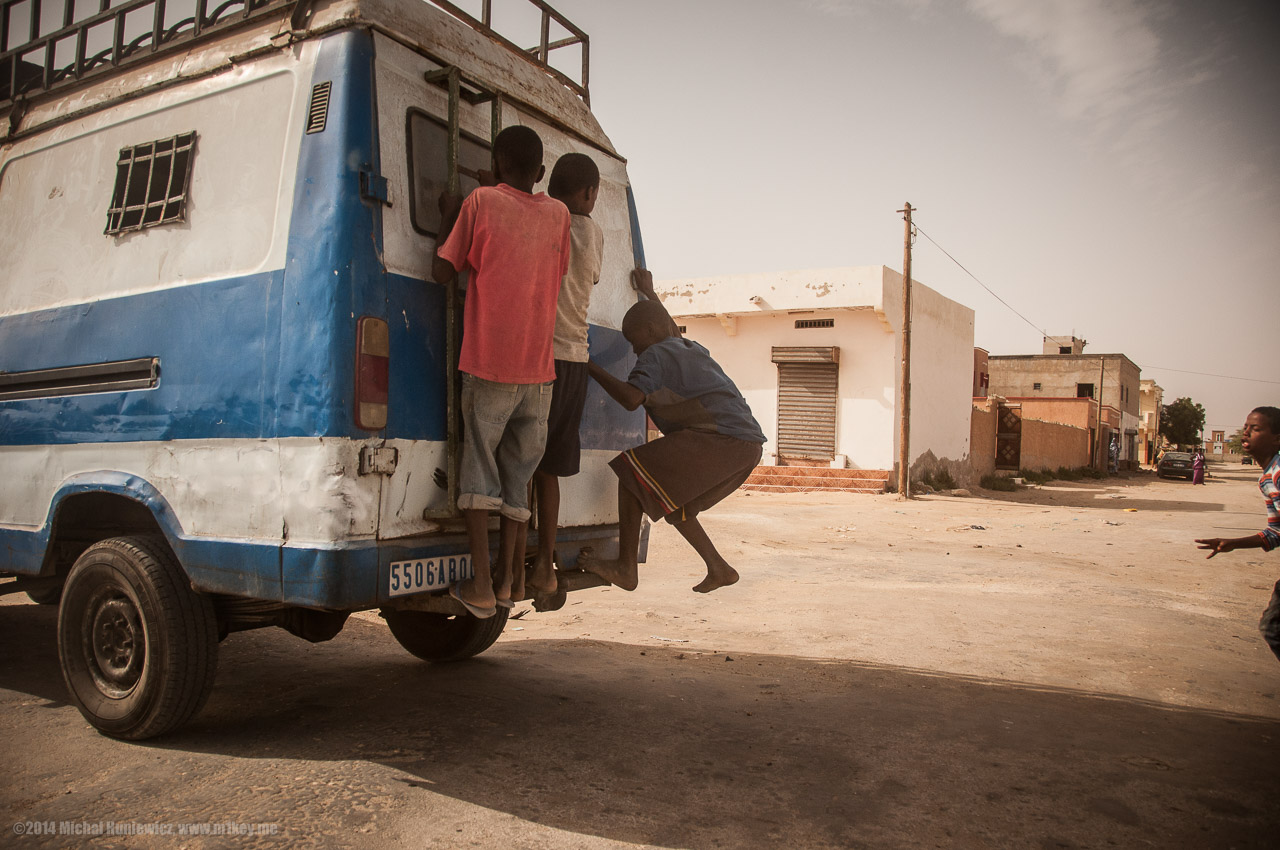
In Nouakchott, we had maybe 10 hours before the flight, so we rented a room just to have a place to store our baggage and shower.
We met lots of really friendly people who really helped us out with getting around, and we got a local blacksmith to make a unique badge for someone back in London
(you couldn't just buy a badge with the Mauritanian flag).
ISO 200, 18mm, f/3.5, 1/5000s.
Grand Mosque - Mosque Saudique
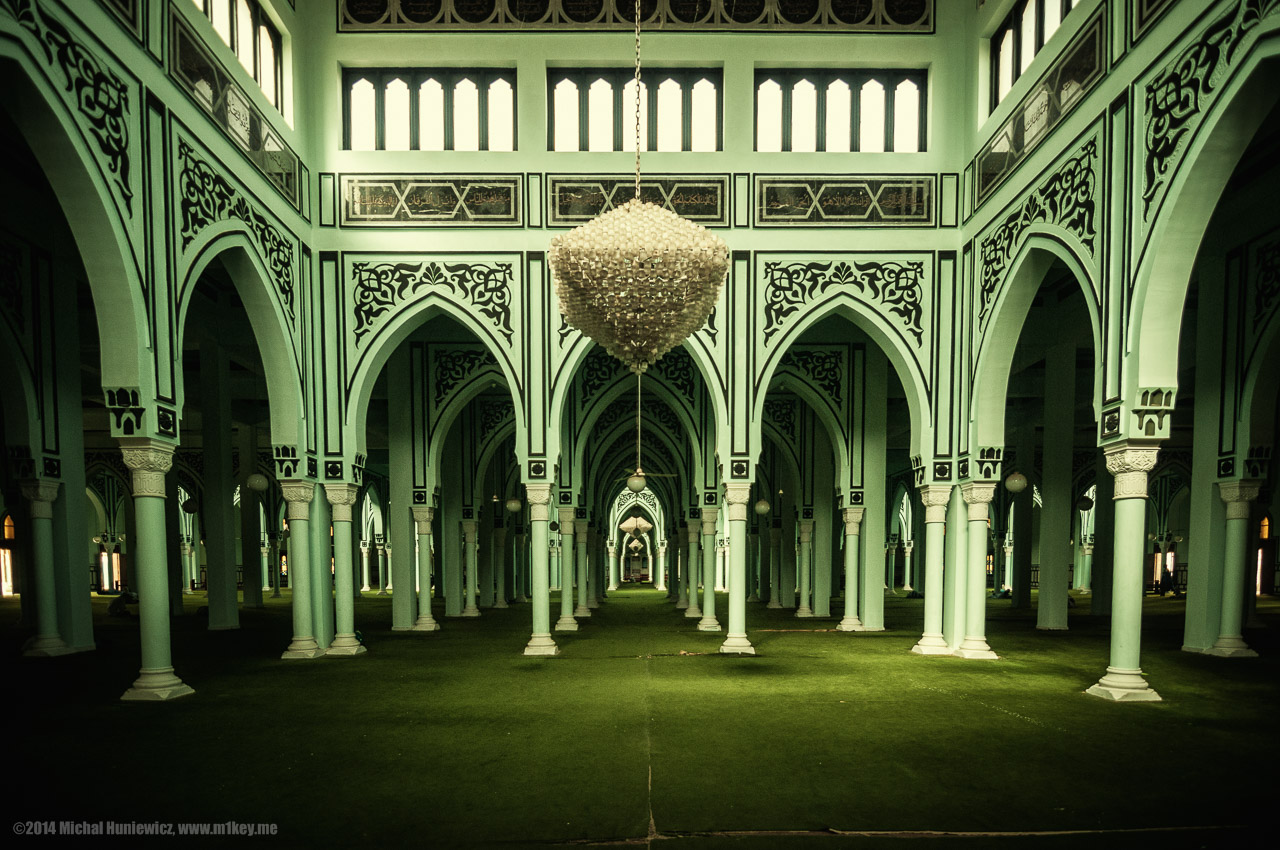
I visited this mosque - it made a big impression on me, being unlike other mosques I've seen before. A bit like an oasis, it offered a refuge from the unbearable temperatures outside.
ISO 200, 11mm, f/2.8, 1/320s.
Like a Garden
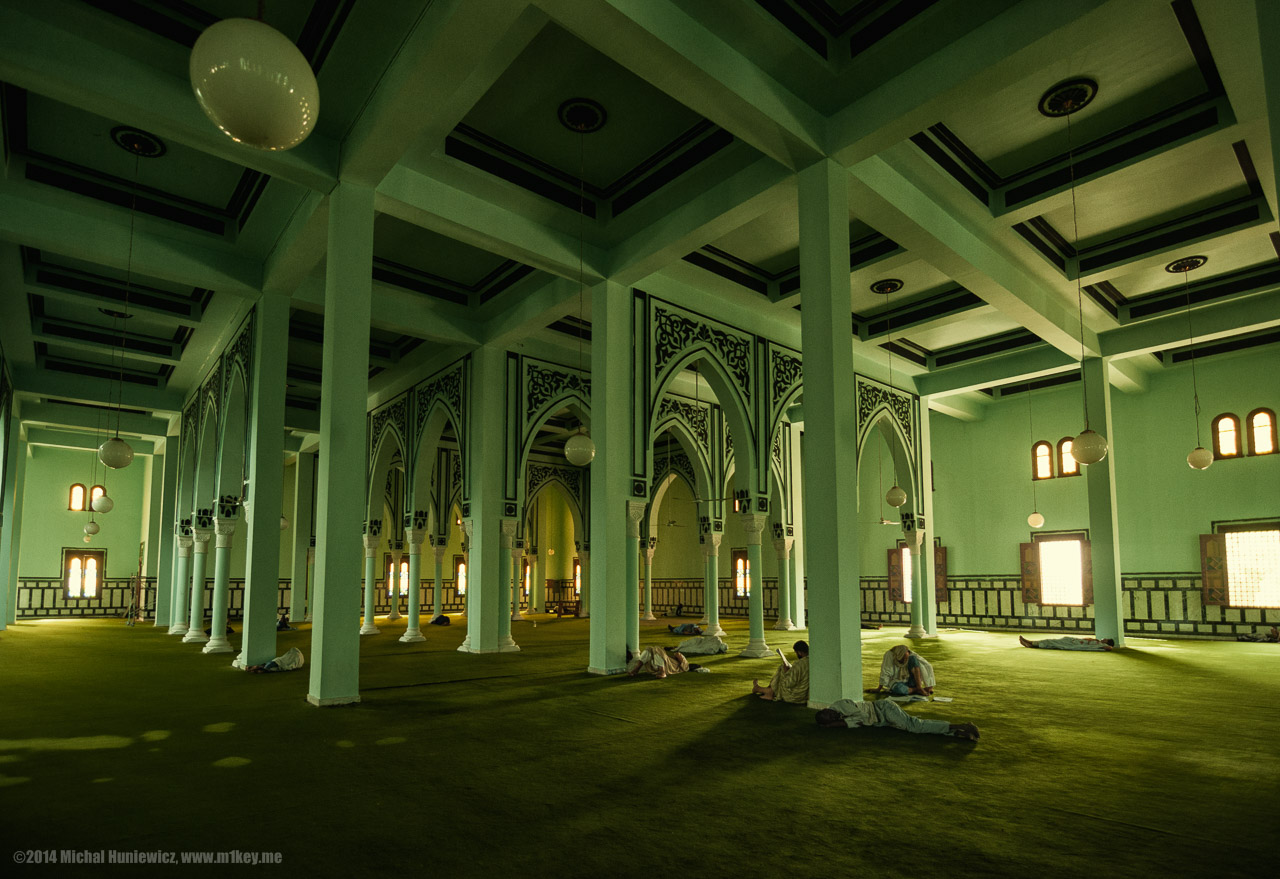
The mosque resembles a garden or a palm tree forest. In fact, you can hear birds singing outside.
Fun fact: In some Saharan countries palm wine is made - "frothy, sharp, agreeable to drink, fizzy" (Robert Hérison [6, p. 58]). I asked, but it seemed to be largely unknown in Mauritania.
You may want to start playing... the soundtrack for the last photo:
Fun fact: In some Saharan countries palm wine is made - "frothy, sharp, agreeable to drink, fizzy" (Robert Hérison [6, p. 58]). I asked, but it seemed to be largely unknown in Mauritania.
You may want to start playing... the soundtrack for the last photo:
ISO 200, 11mm, f/2.8, 1/50s.
Eyes Towards Minefields
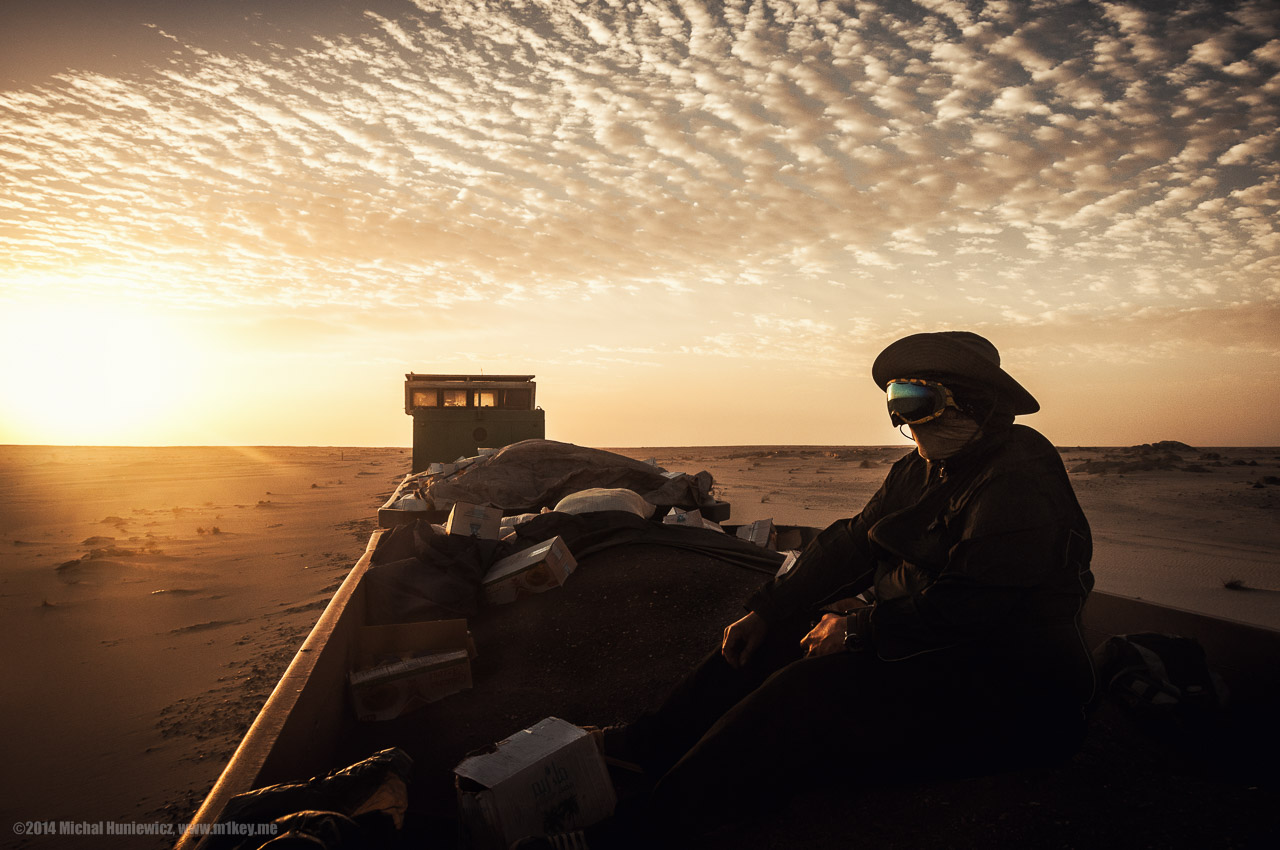
Soon afterwards, we had to go to the airport, where we would end up being interrogated in a claustrophobic room, and especially Ammar got yelled at a lot.
Also, they took away almost all of our local cash and all my batteries. Our baggage got checked a countless number of times, including on the runway in front of
the stairs to the plane...
Ammar: [The airport] seemed as empty as when we had arrived 7 days earlier. [...] We went through a security check on our bags. But we weren't done yet.
[...]The guard got up and ordered me to stand there. He walked a few metres to the side where behind a door lay an office. In the office was a man in white robes, sat at a desk lit up from a lamp on it. The guard spoke to this seemingly important man and gesticulated at me. The man at the desk stared at me intently. I was already a rabbit in the headlights. Frozen. He beckoned me to approach him. So I walked into the room. The guard remained with us for a few minutes but then disappeared.
The man at the desk unnerved me. He seemed.....angry. Dangerous. I didn't feel safe from the moment he looked at me. He asked me where I was from. And then asked me how I could be born in Baghdad but have a British passport. I tried to explain these things but I suddenly realised my pidgin-French and Arabic that had worked with taxi drivers, waiters, sellers, etc. was useless here. I looked and sounded sort-of Arabic, yet I had a UK passport. That didn't make sense in his eyes. I got the feeling someone from the UK would be born in the UK was his view.
[...] My throat dried up, my voice almost raised an octave, and I was beginning to stammer. He asked me for my ID card. I said I didn't have one. He said of course I did. I repeated that I didn't have one. This conversation carried on in this way for about 2 minutes. I repeated in as many different ways that the UK don't have ID cards. The passport was my ID. And why would I lie. What I should have asked (but was struck dumb with fear) was what the problem was. He never really made it clear. His glare just insinuated I was guilty and my appearance was only too happy to confirm his suspicions.
At this point some sort of inspiration struck [Actually, it was me who told him - Michal]. I remembered that, beyond the passport with my visa, I had a pack full of paper work for the holiday - insurance, a letter confirming my employment [Only two countries required my proof of employment to let me in or out: Mauritania and the US - Michal], a letter of invitation from a hotel, my medical card, my hotel and flight bookings. I took them all out and handed them to the man at the desk. He sifted through them, and I heard him muttering things about the medical card, the letters of approval the insurance, and other papers. After about two minutes, with Michal still stood next to me, the man at the desk shoved the papers to the desk below me, handed the [Polish] ID card back to Michal, and without looking at us, threw his hand towards the door in a shooing manner.
That was it. We were free to go. No words. Just the shooing movement.
[...] Finally we got the call to get on the plane. You thought the security checks were over? You thought wrong! There was two checks of our papers and ANOTHER bag check. And then one last paper check. I was almost pushed along by Michal. At every point I half expected them to say there was a problem and for me to be pulled back to some other part of the airport.
Even when I got on the plane, it wasn't over for me. We were there for quite some time. I could almost taste freedom but while we were on the ground I didn't feel safe. It's a shame the holiday had soured on this last day. The rest of my time in Mauritania was amazing, the people were amazing. Finally we took off, and at last I had a bit of a smile. I proceeded to put my mind off what had just happened by watching Disney's Frozen. I recommend it.
What an adventure! Not a lot of it would have been possible without Ammar's linguistic skills, so شكرا for coming (and for general patience), Ammar.
Ammar: [The airport] seemed as empty as when we had arrived 7 days earlier. [...] We went through a security check on our bags. But we weren't done yet.
[...]The guard got up and ordered me to stand there. He walked a few metres to the side where behind a door lay an office. In the office was a man in white robes, sat at a desk lit up from a lamp on it. The guard spoke to this seemingly important man and gesticulated at me. The man at the desk stared at me intently. I was already a rabbit in the headlights. Frozen. He beckoned me to approach him. So I walked into the room. The guard remained with us for a few minutes but then disappeared.
The man at the desk unnerved me. He seemed.....angry. Dangerous. I didn't feel safe from the moment he looked at me. He asked me where I was from. And then asked me how I could be born in Baghdad but have a British passport. I tried to explain these things but I suddenly realised my pidgin-French and Arabic that had worked with taxi drivers, waiters, sellers, etc. was useless here. I looked and sounded sort-of Arabic, yet I had a UK passport. That didn't make sense in his eyes. I got the feeling someone from the UK would be born in the UK was his view.
[...] My throat dried up, my voice almost raised an octave, and I was beginning to stammer. He asked me for my ID card. I said I didn't have one. He said of course I did. I repeated that I didn't have one. This conversation carried on in this way for about 2 minutes. I repeated in as many different ways that the UK don't have ID cards. The passport was my ID. And why would I lie. What I should have asked (but was struck dumb with fear) was what the problem was. He never really made it clear. His glare just insinuated I was guilty and my appearance was only too happy to confirm his suspicions.
At this point some sort of inspiration struck [Actually, it was me who told him - Michal]. I remembered that, beyond the passport with my visa, I had a pack full of paper work for the holiday - insurance, a letter confirming my employment [Only two countries required my proof of employment to let me in or out: Mauritania and the US - Michal], a letter of invitation from a hotel, my medical card, my hotel and flight bookings. I took them all out and handed them to the man at the desk. He sifted through them, and I heard him muttering things about the medical card, the letters of approval the insurance, and other papers. After about two minutes, with Michal still stood next to me, the man at the desk shoved the papers to the desk below me, handed the [Polish] ID card back to Michal, and without looking at us, threw his hand towards the door in a shooing manner.
That was it. We were free to go. No words. Just the shooing movement.
[...] Finally we got the call to get on the plane. You thought the security checks were over? You thought wrong! There was two checks of our papers and ANOTHER bag check. And then one last paper check. I was almost pushed along by Michal. At every point I half expected them to say there was a problem and for me to be pulled back to some other part of the airport.
Even when I got on the plane, it wasn't over for me. We were there for quite some time. I could almost taste freedom but while we were on the ground I didn't feel safe. It's a shame the holiday had soured on this last day. The rest of my time in Mauritania was amazing, the people were amazing. Finally we took off, and at last I had a bit of a smile. I proceeded to put my mind off what had just happened by watching Disney's Frozen. I recommend it.
What an adventure! Not a lot of it would have been possible without Ammar's linguistic skills, so شكرا for coming (and for general patience), Ammar.
ISO 200, 18mm, f/8.0, 1/400s.
